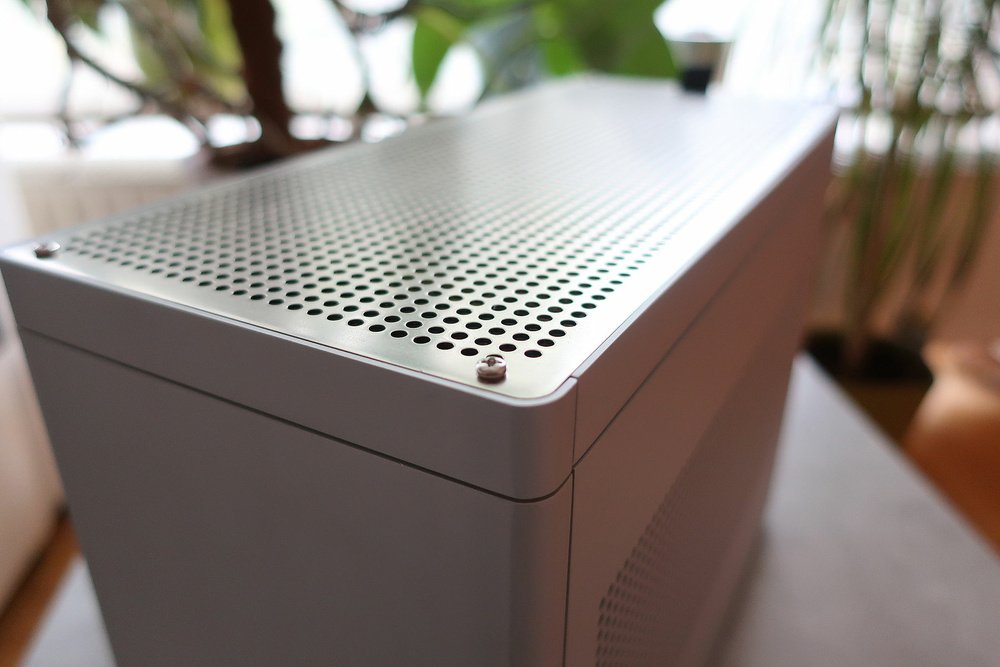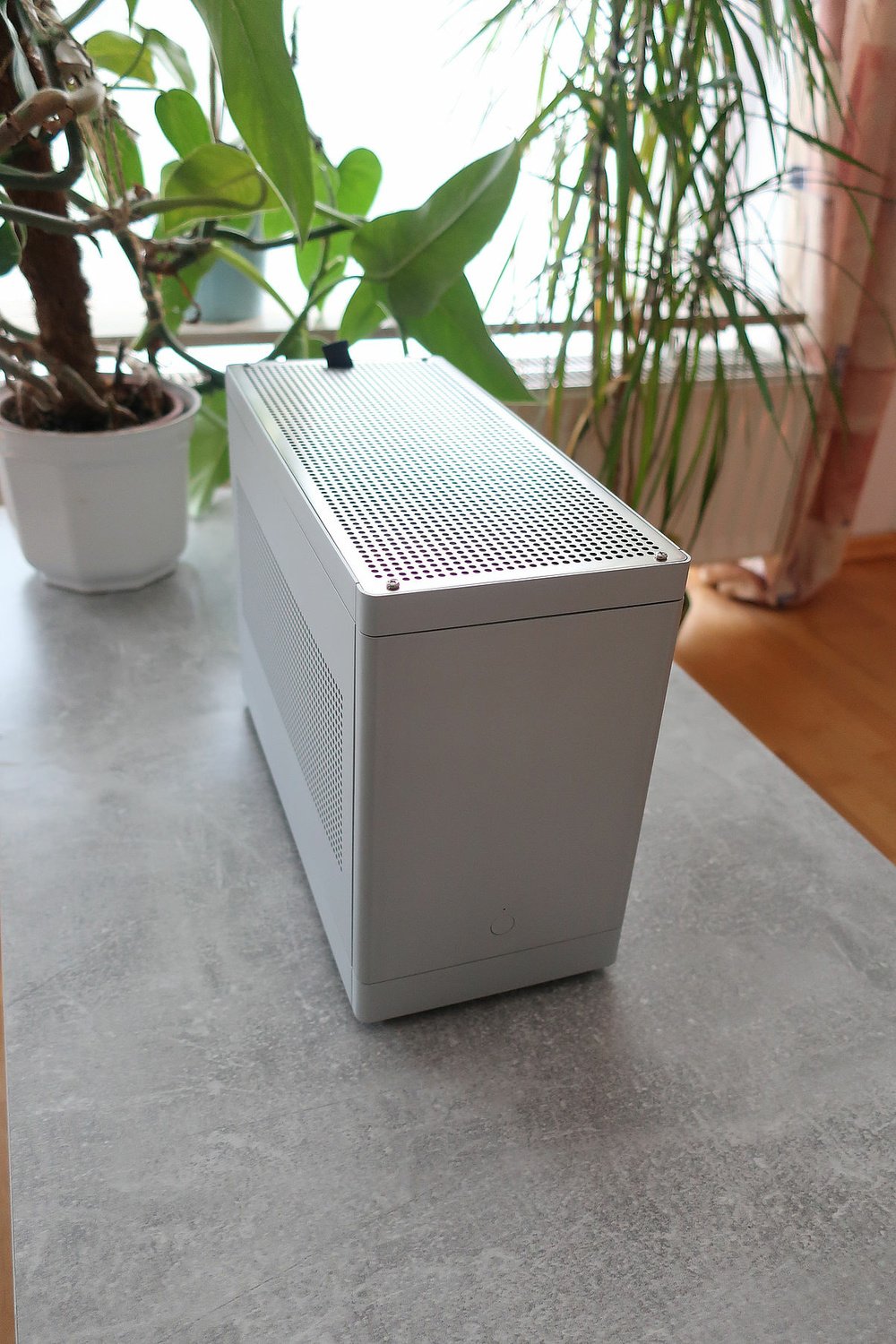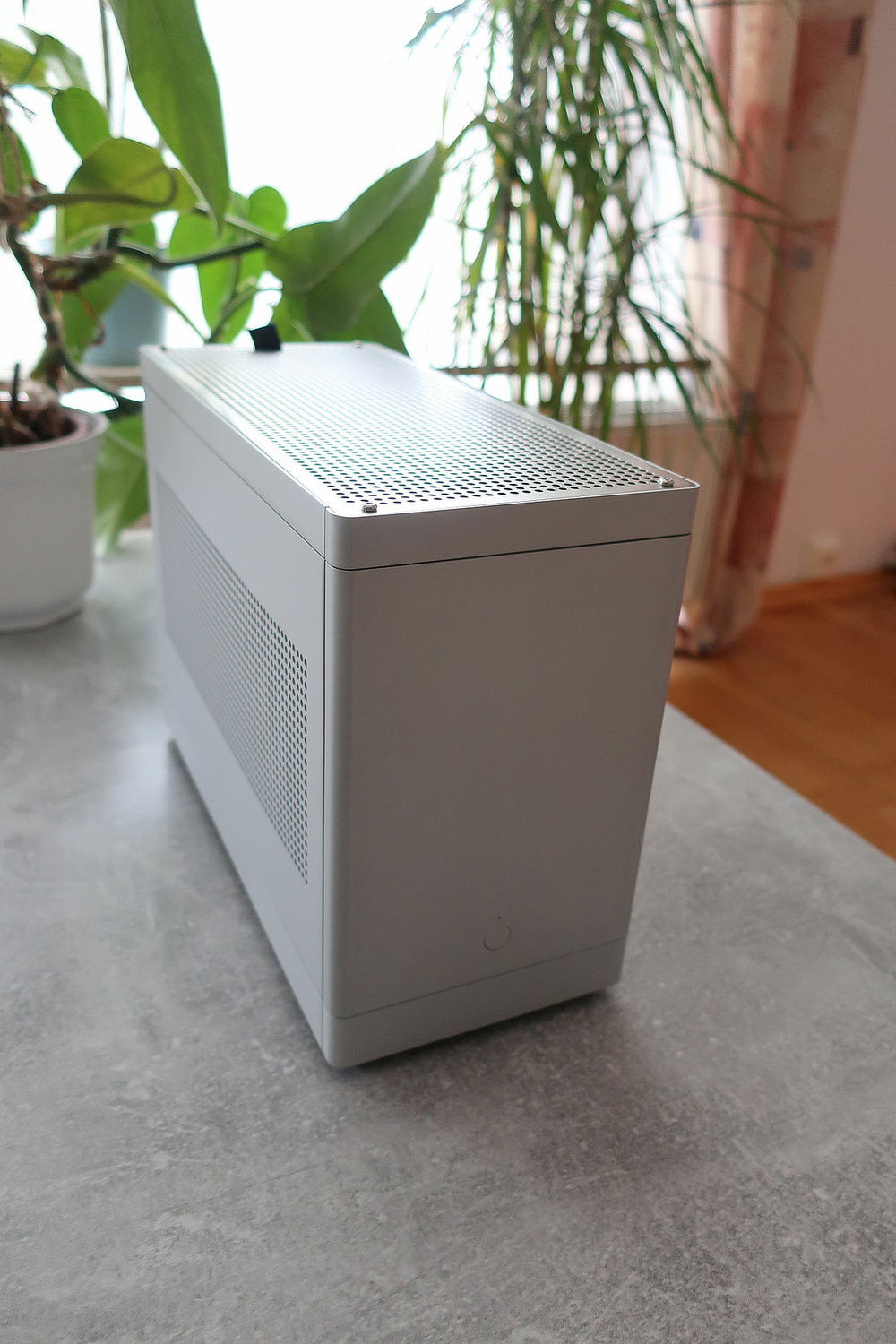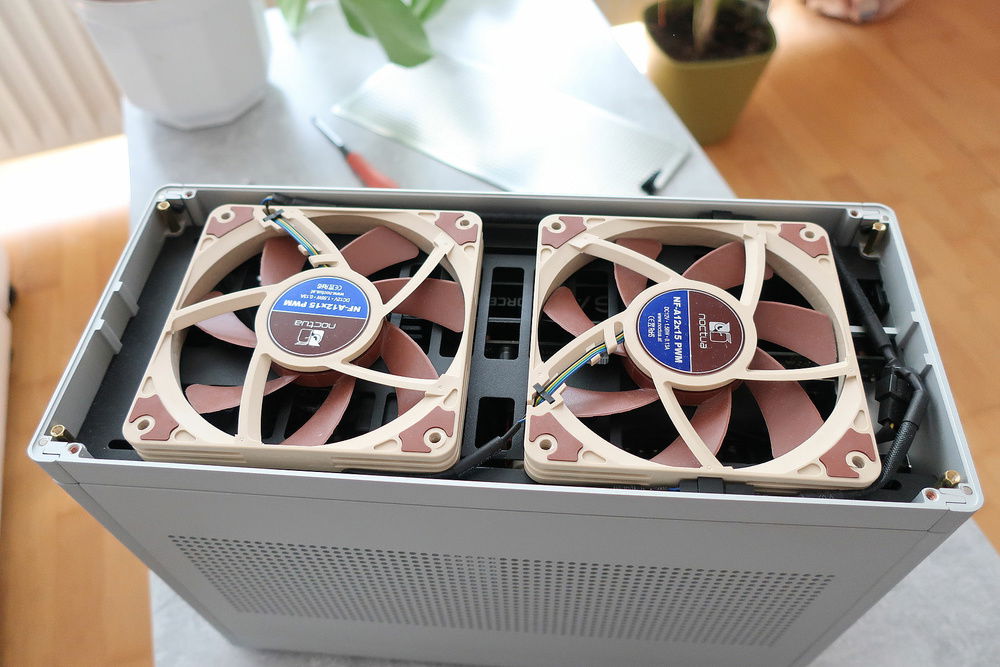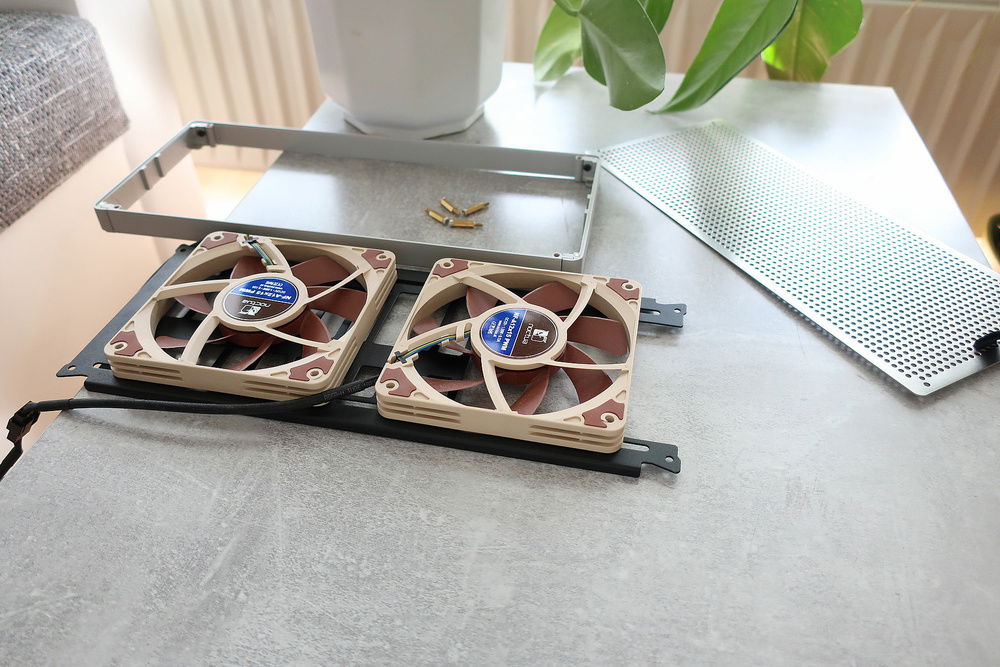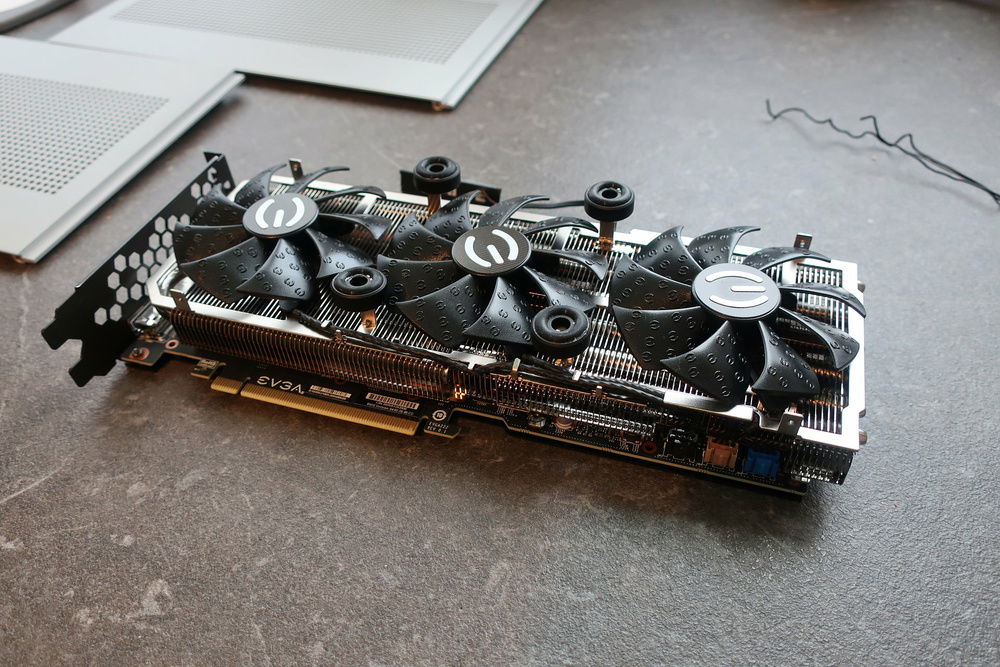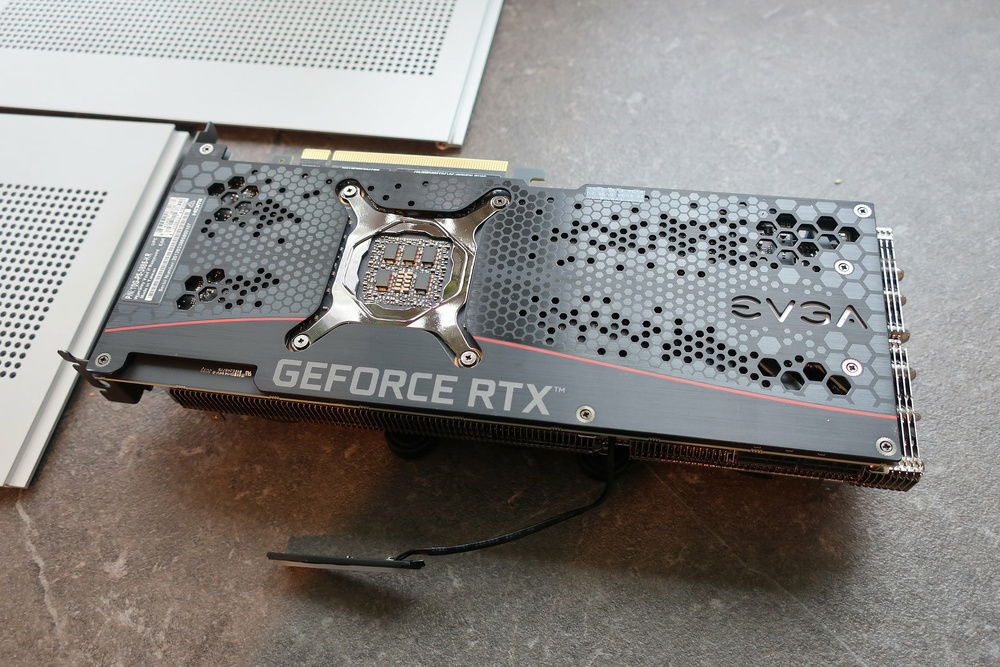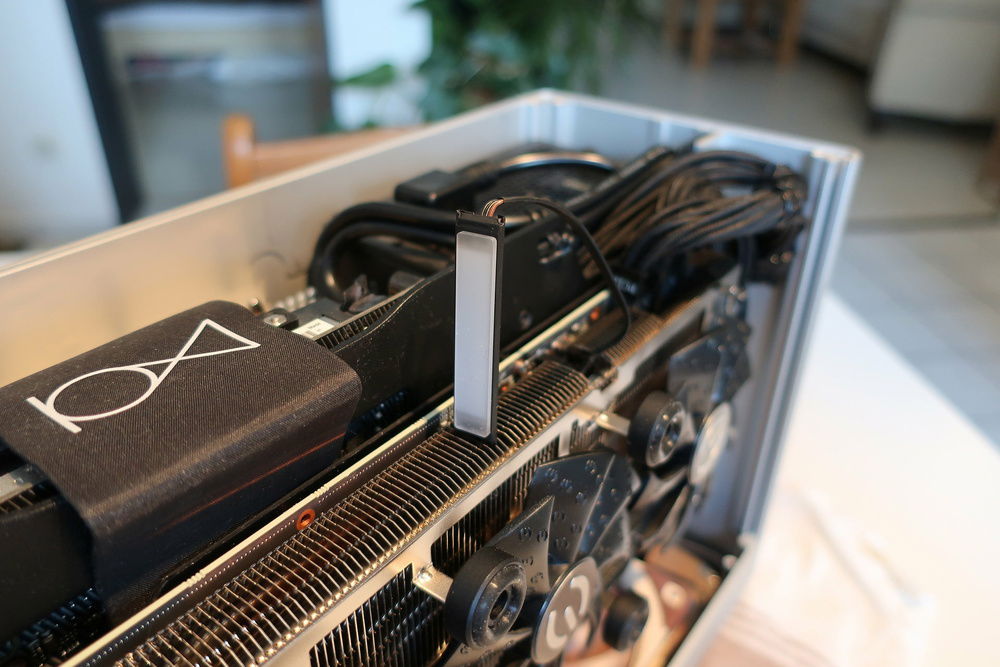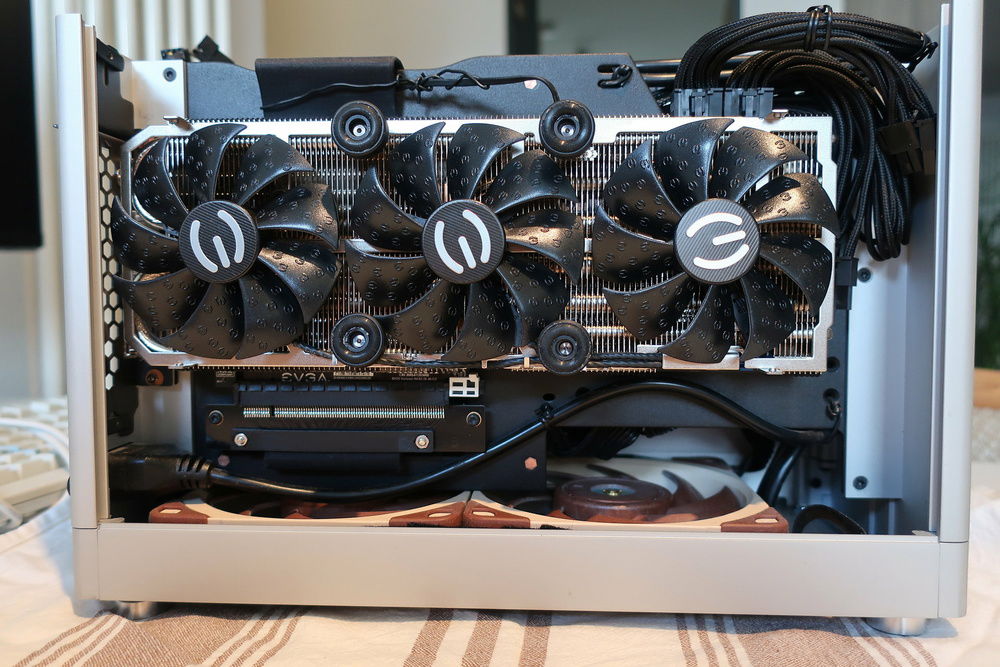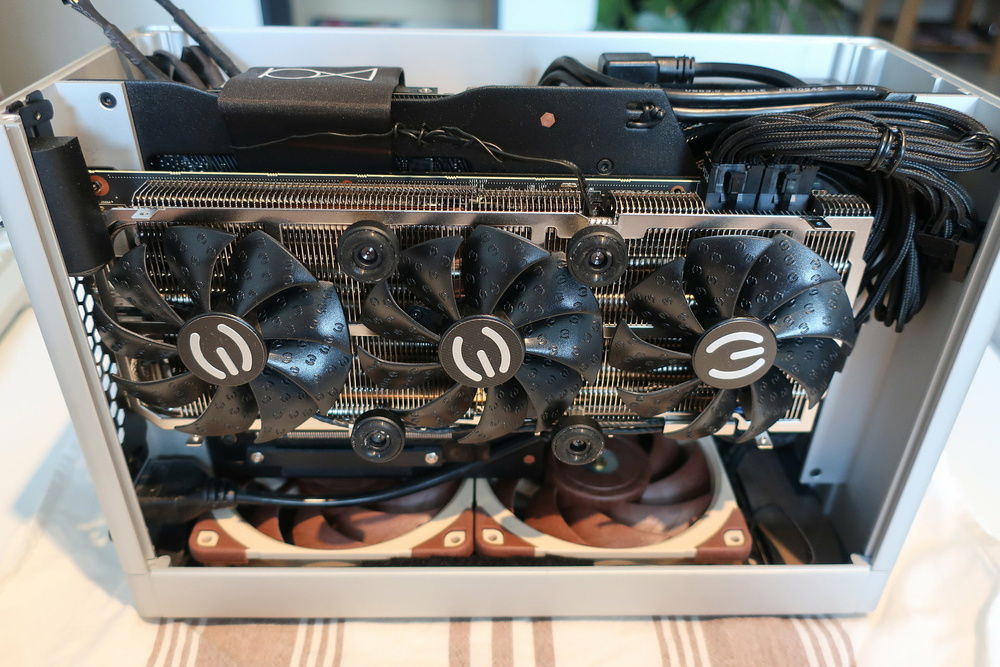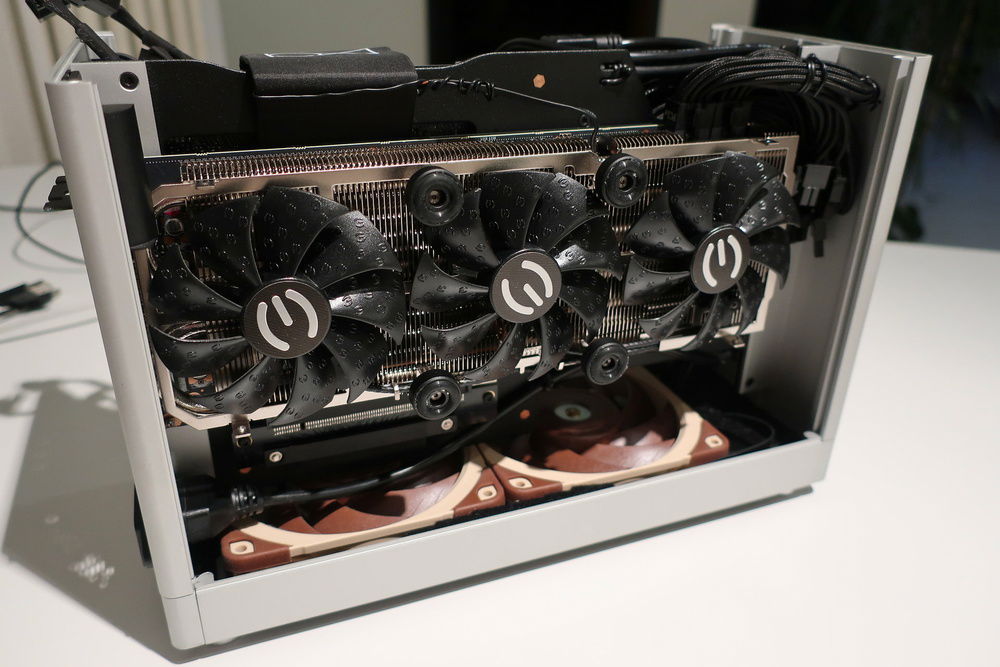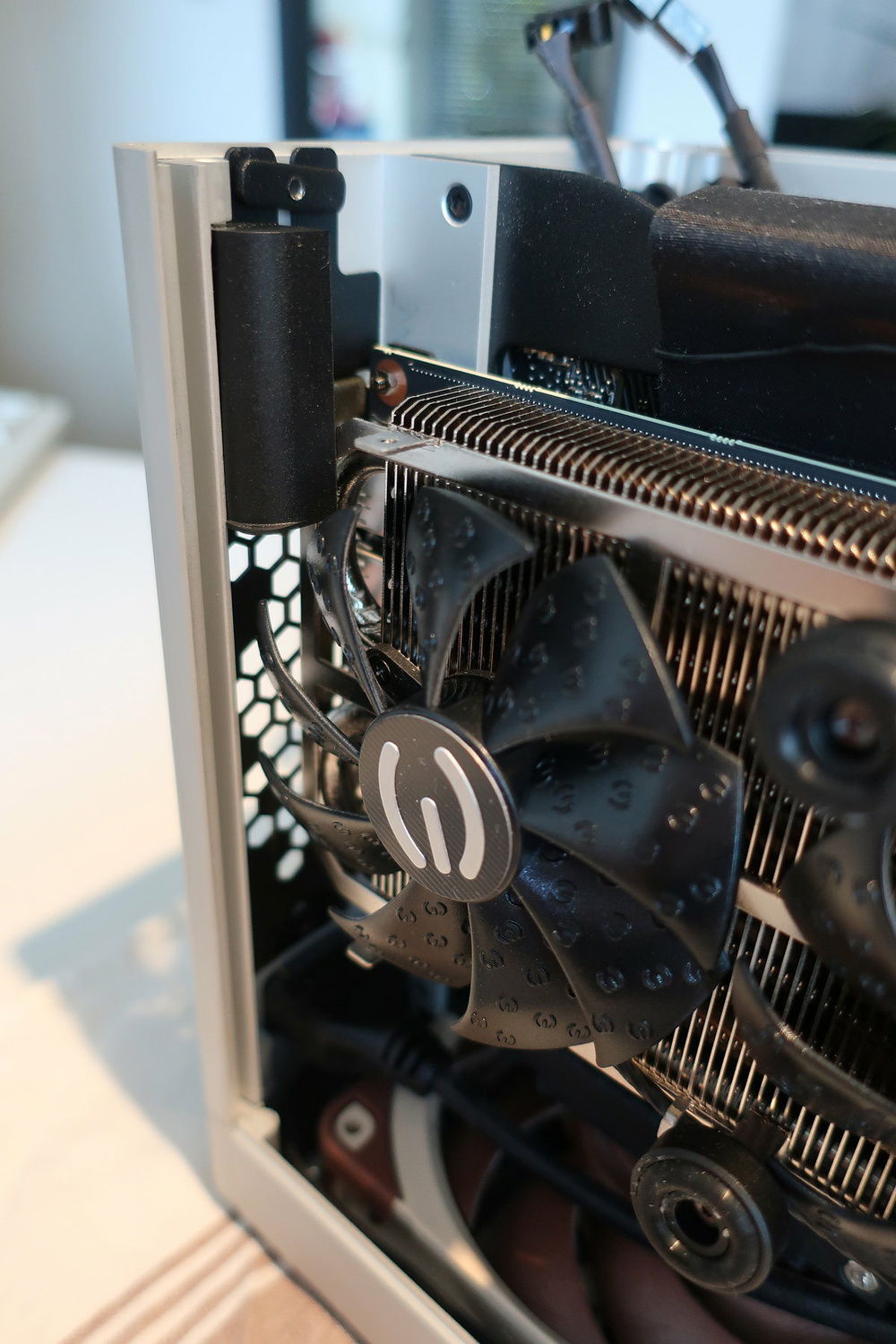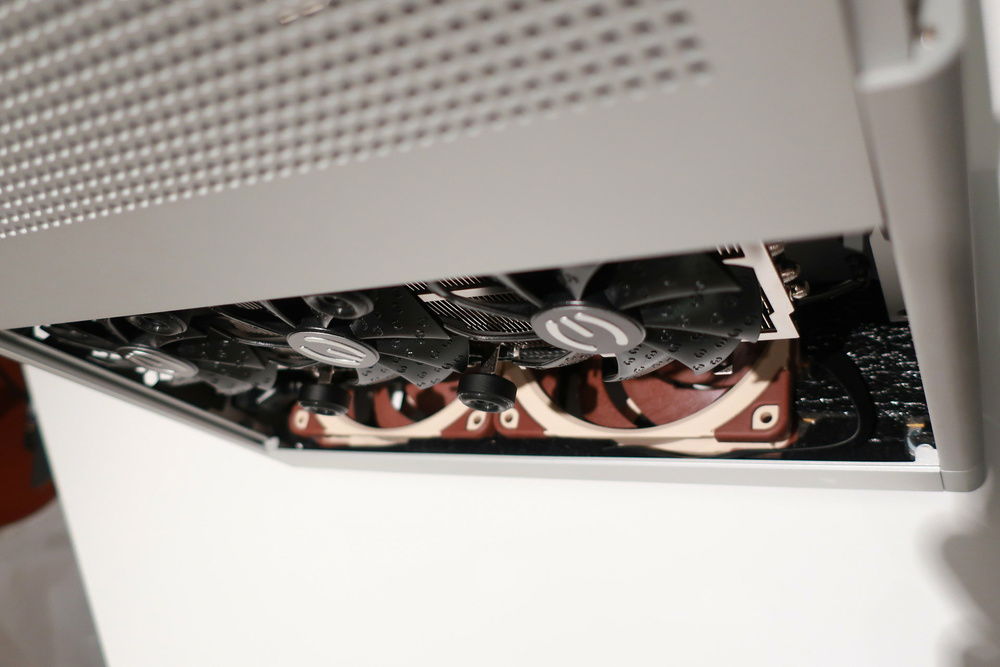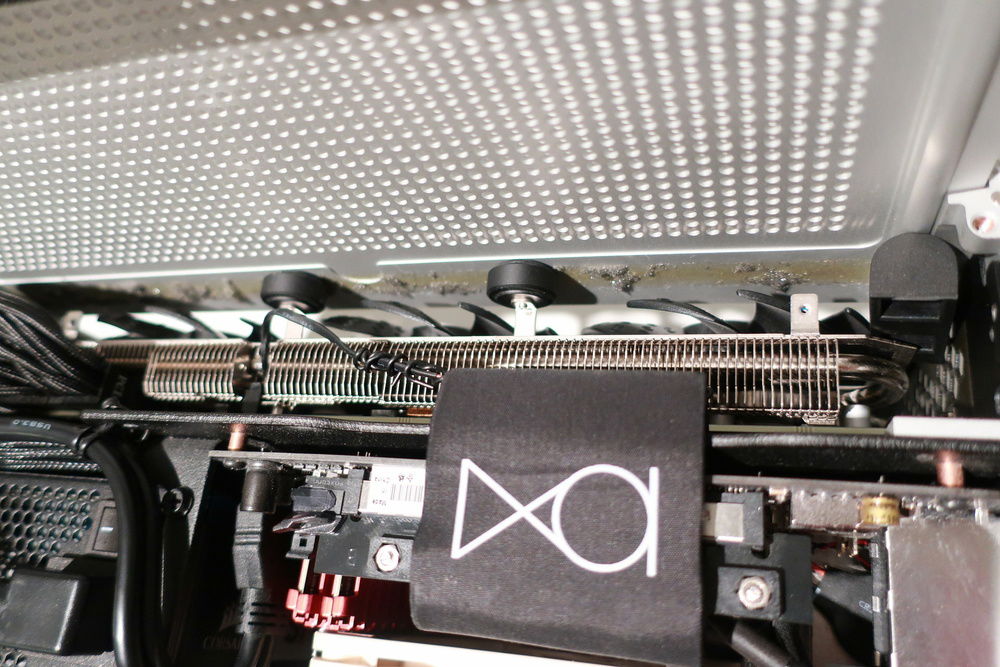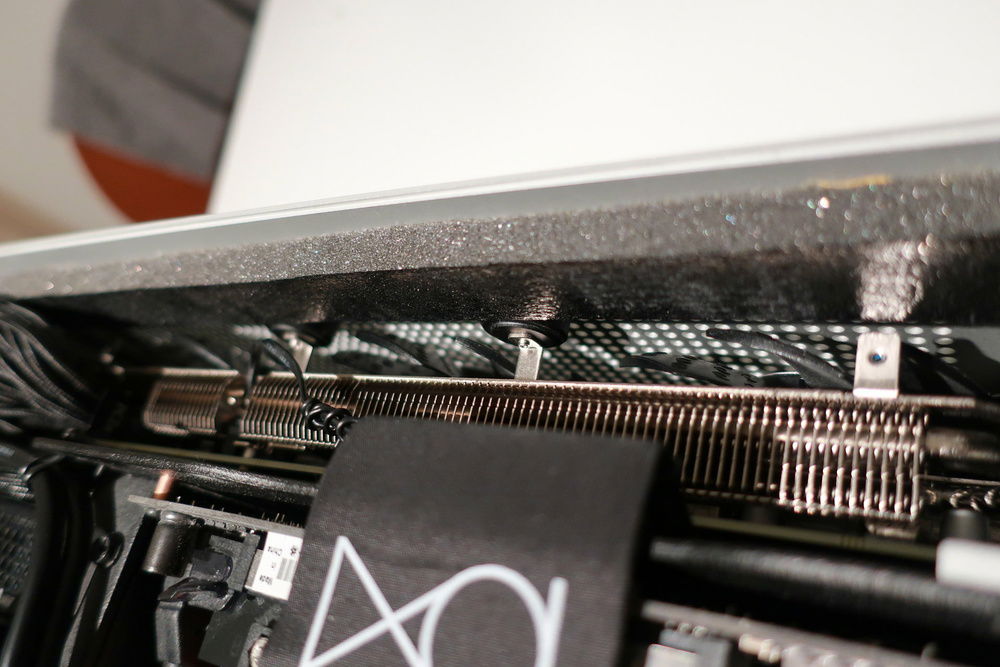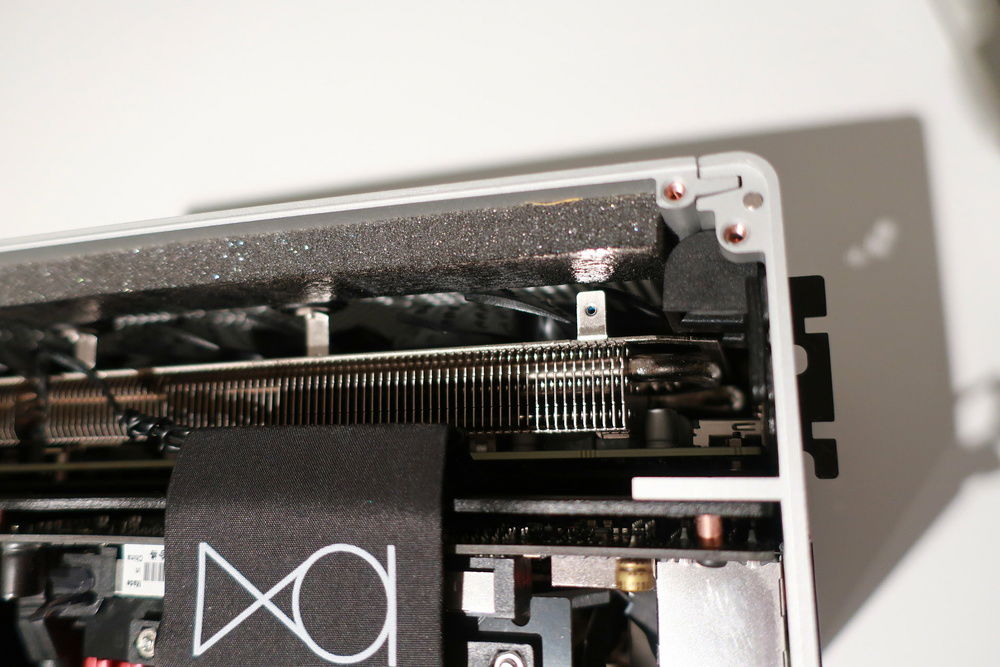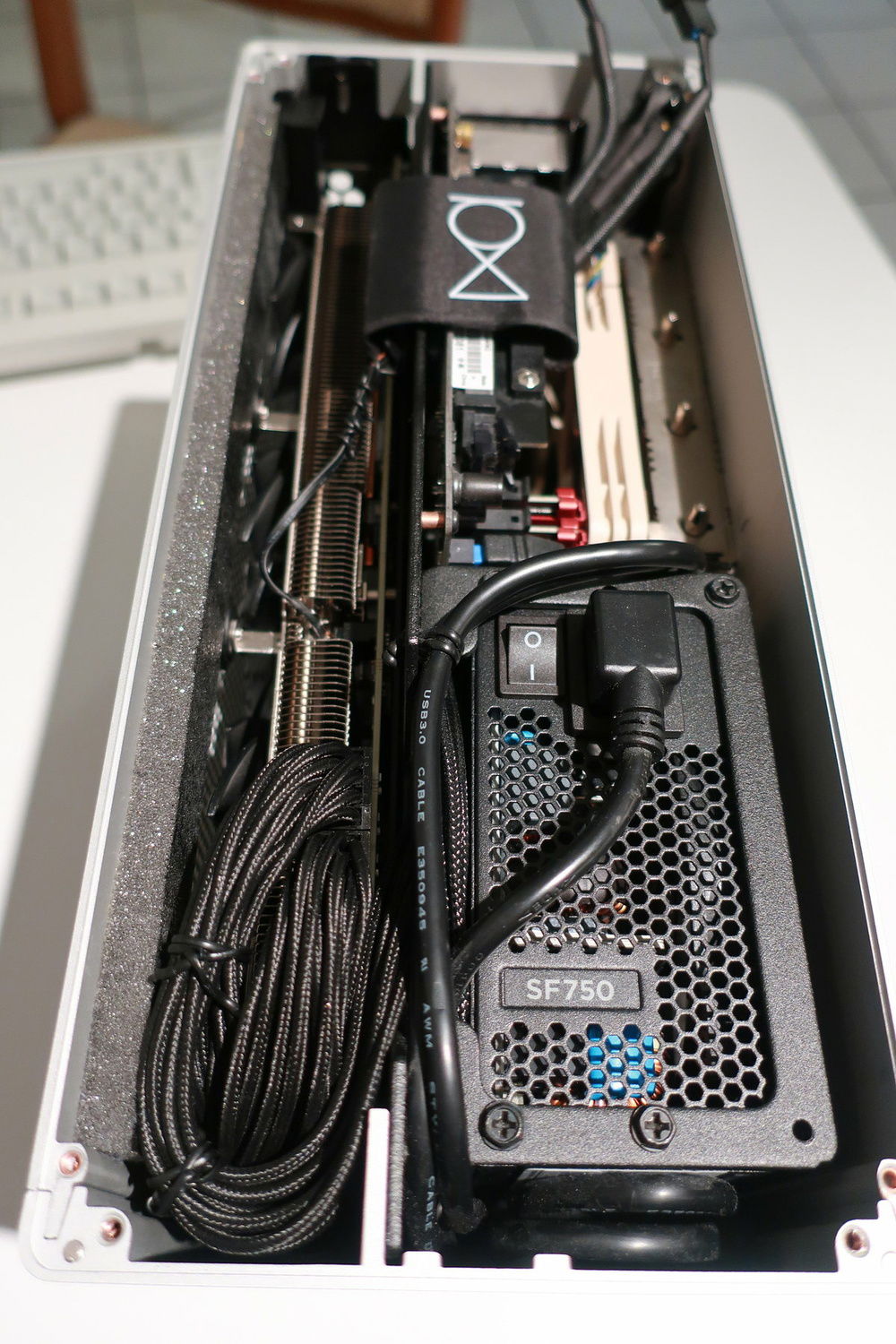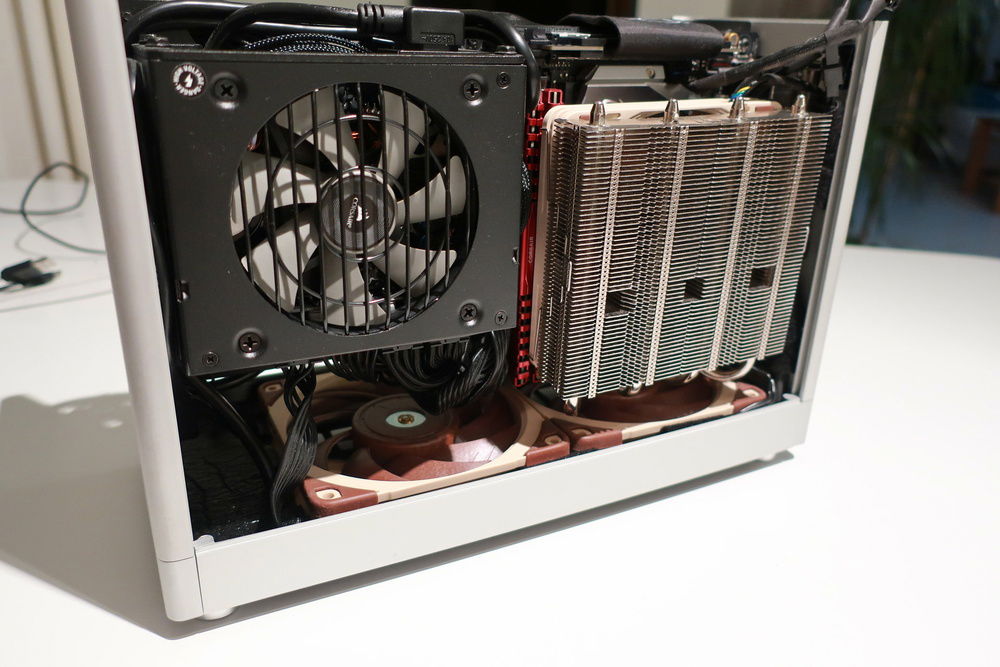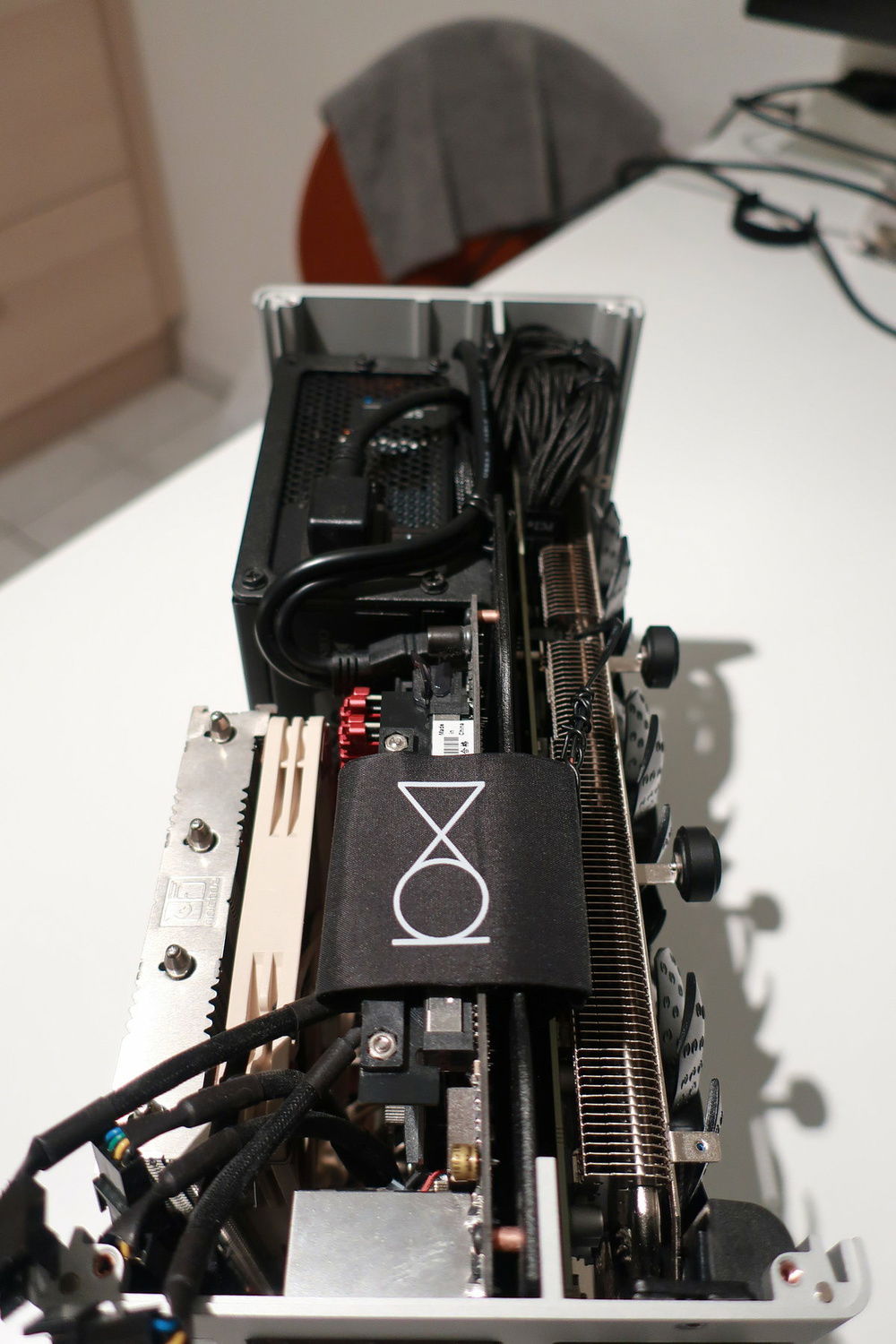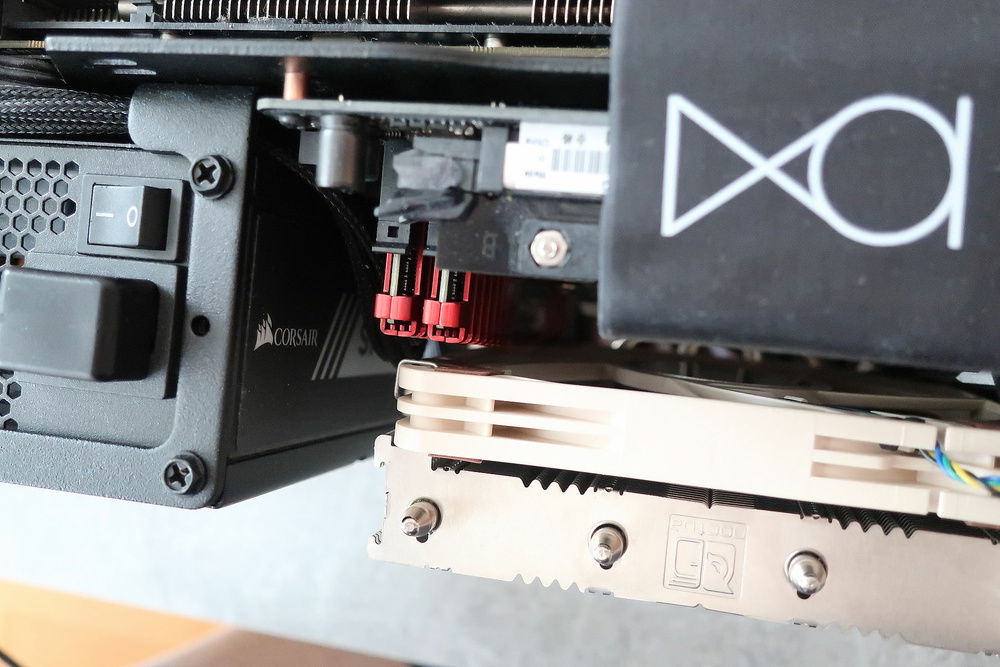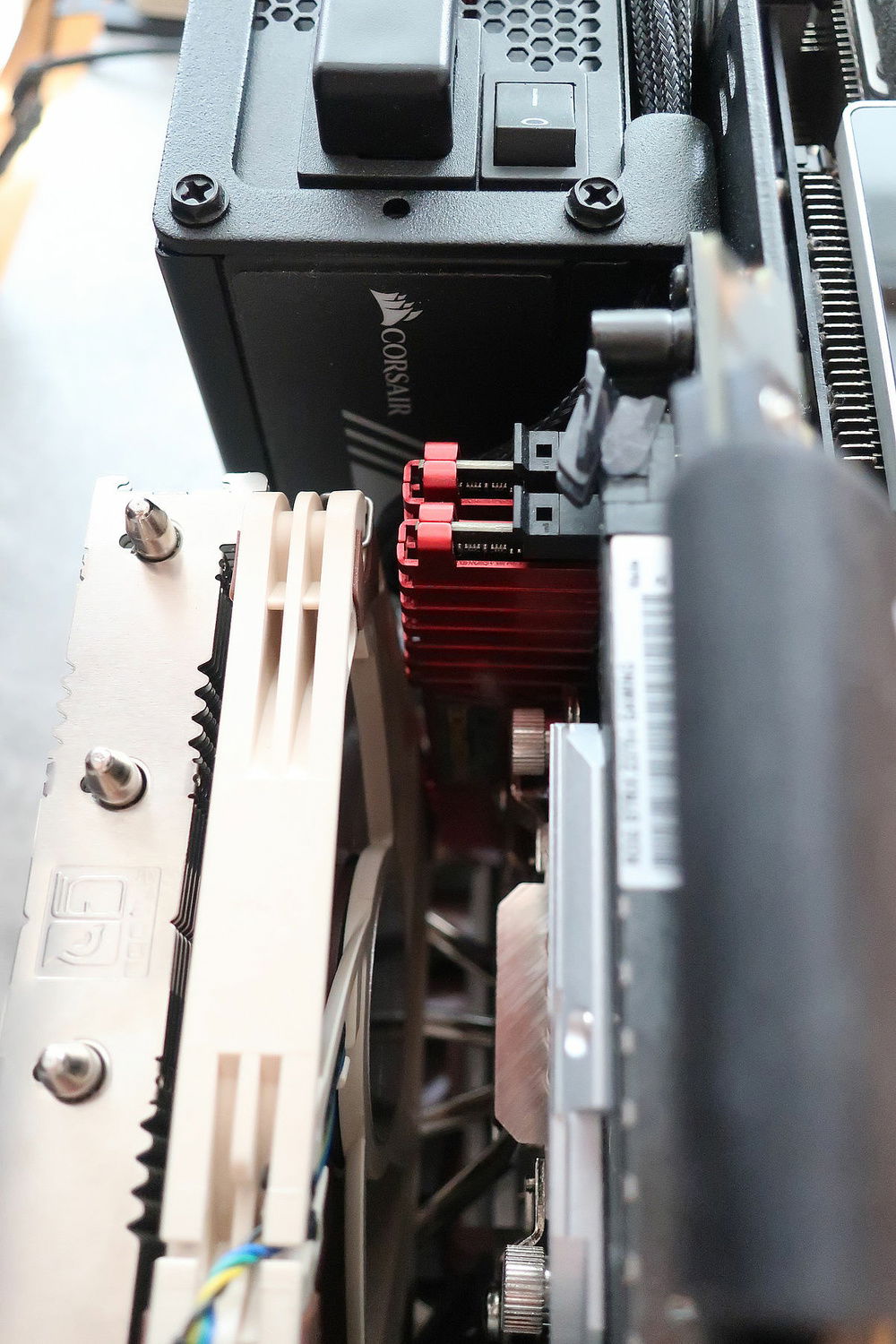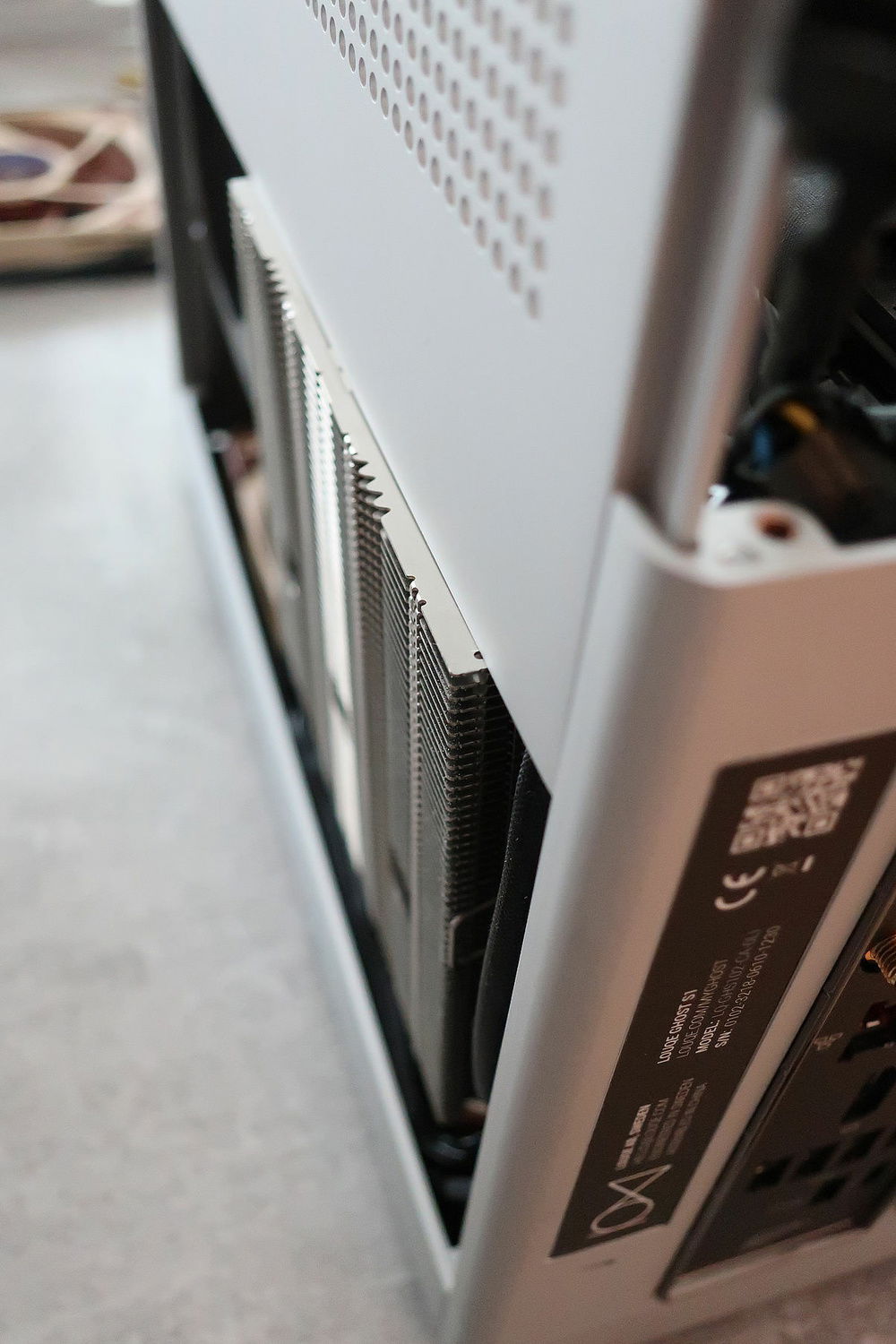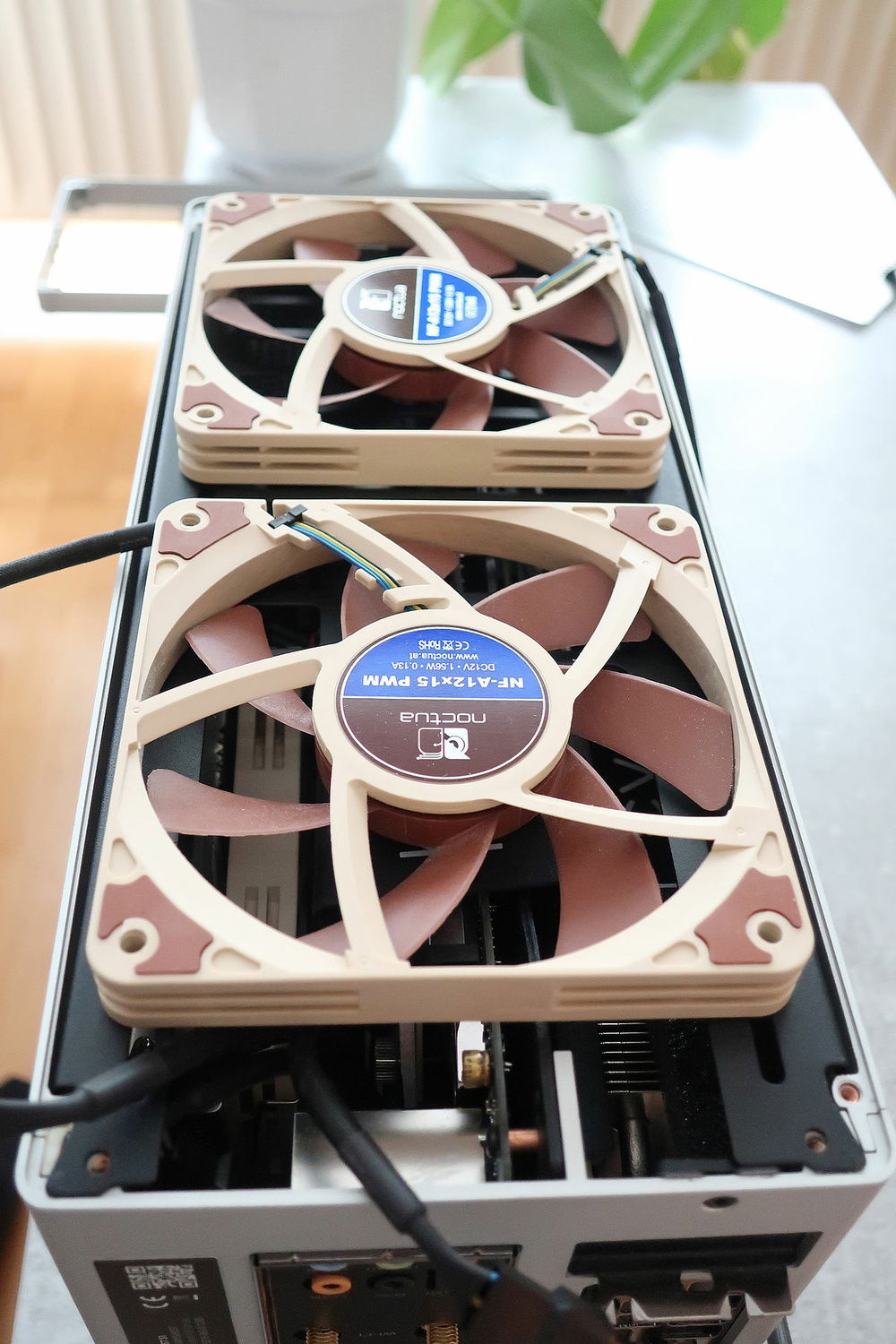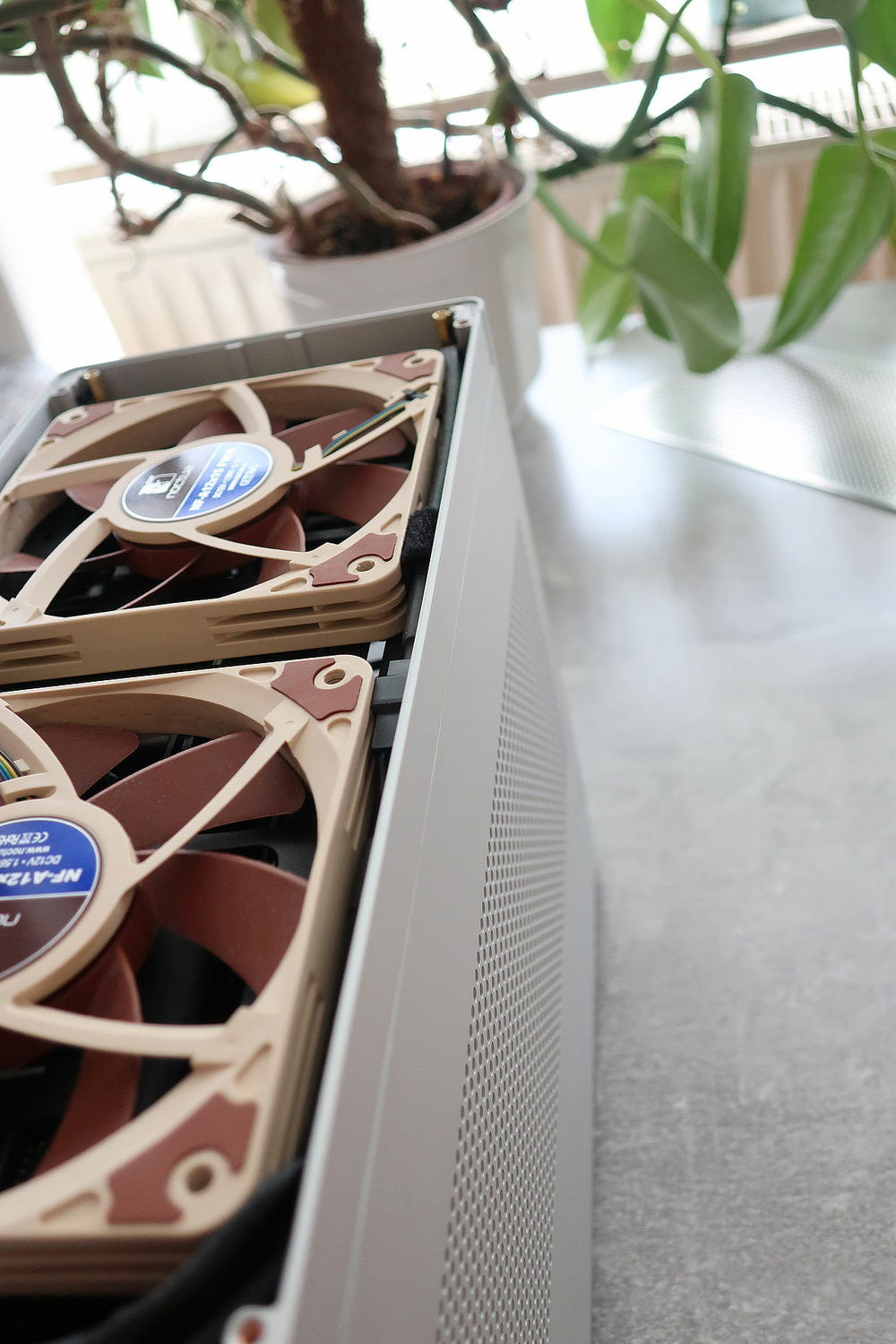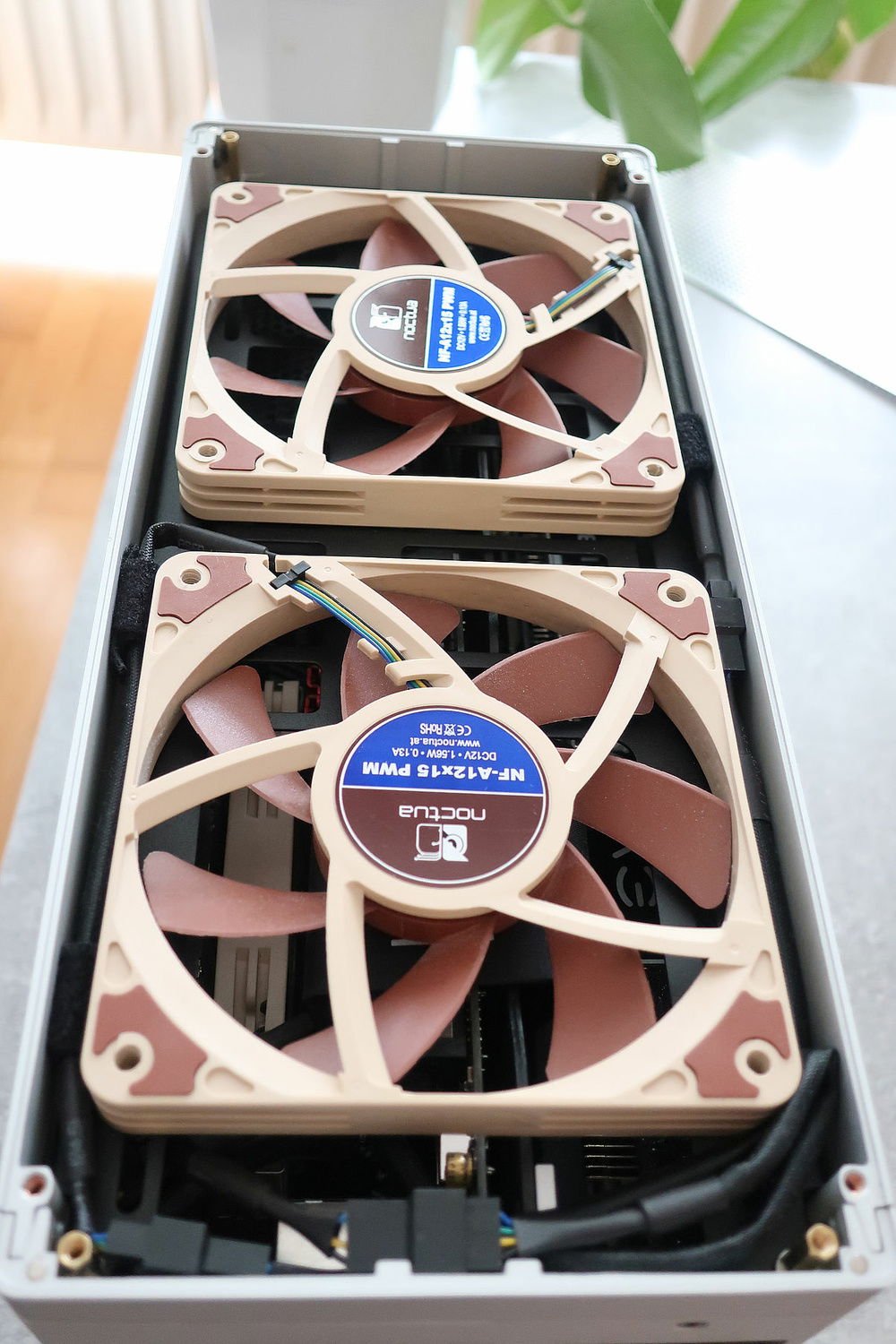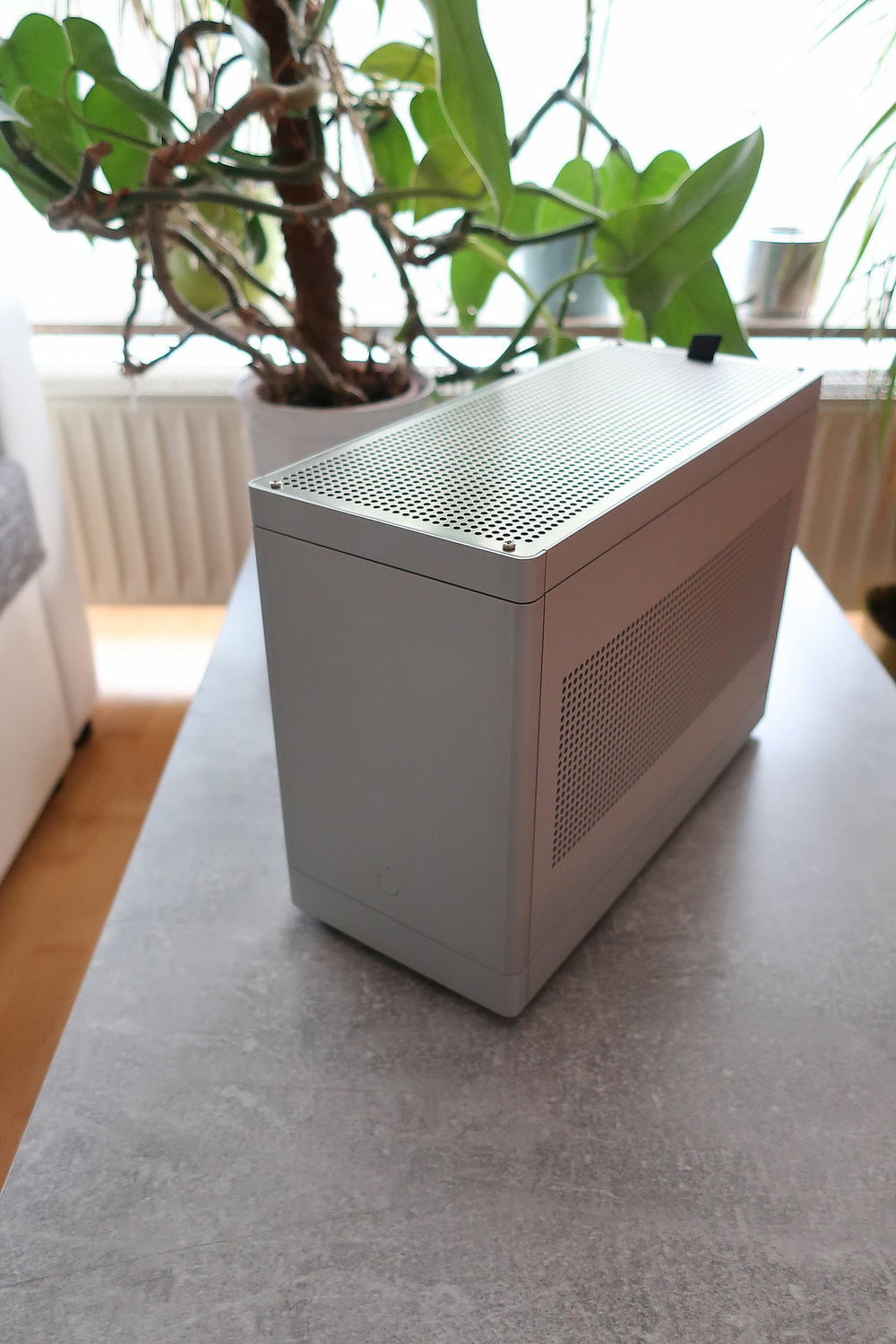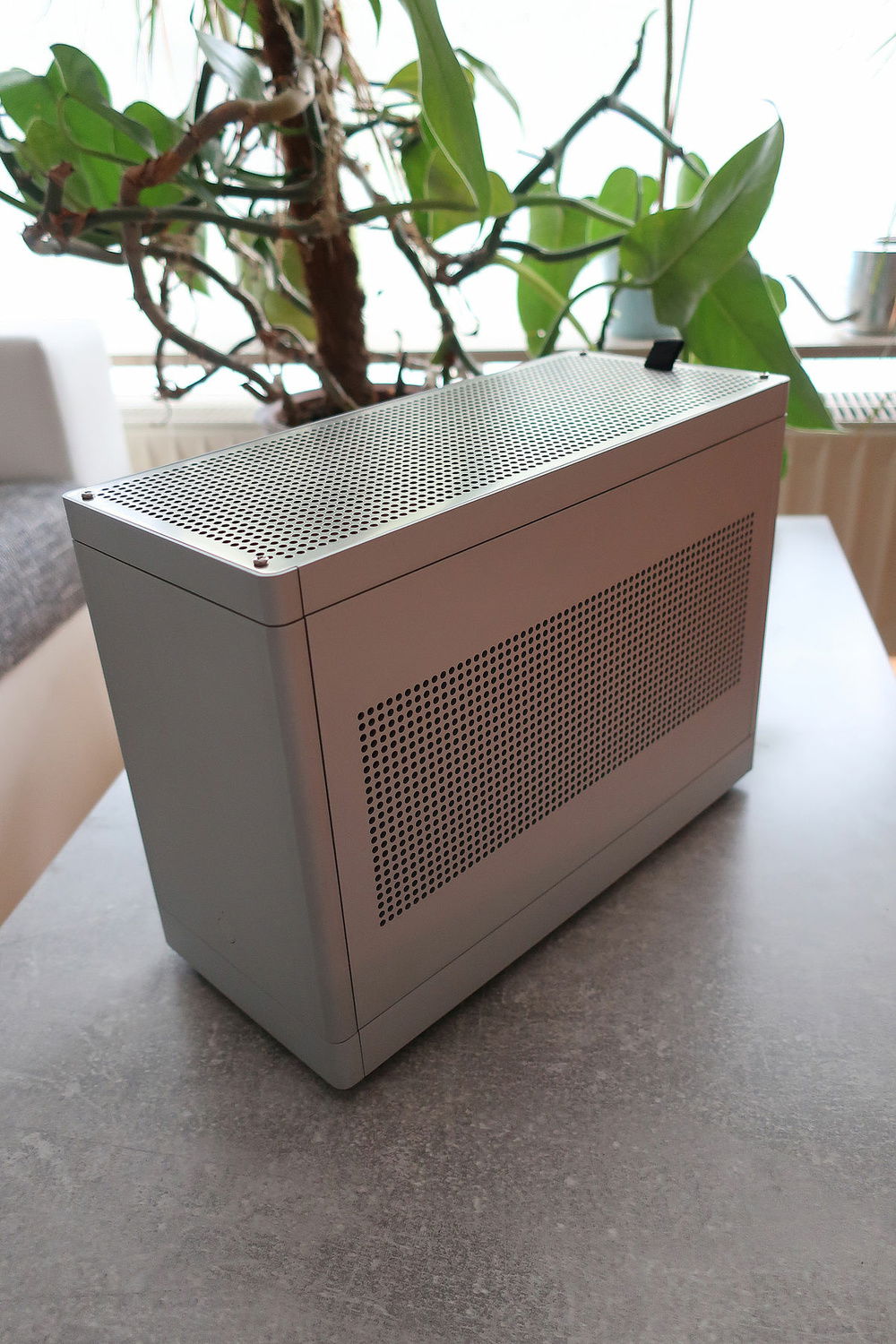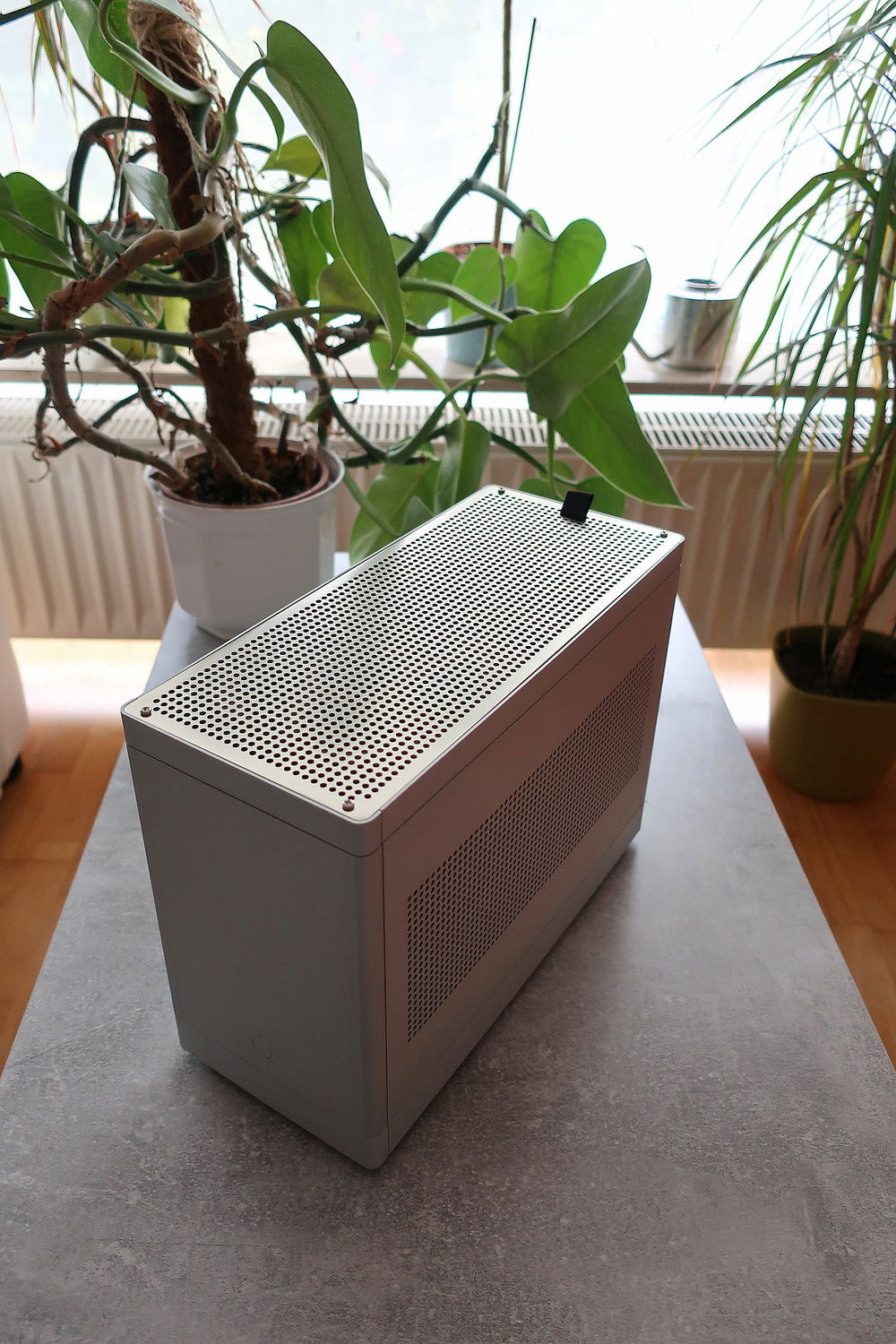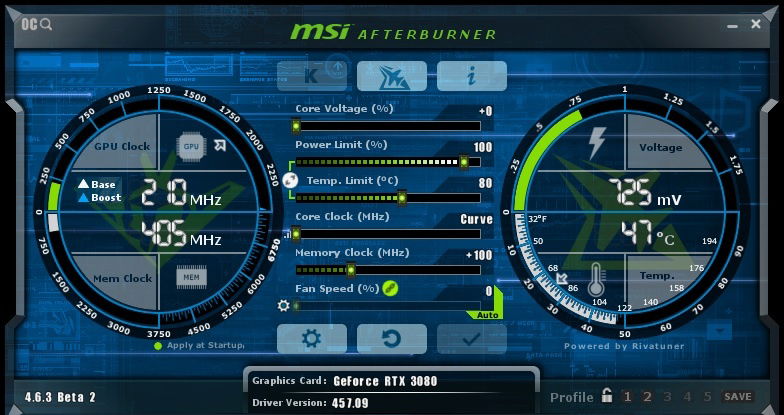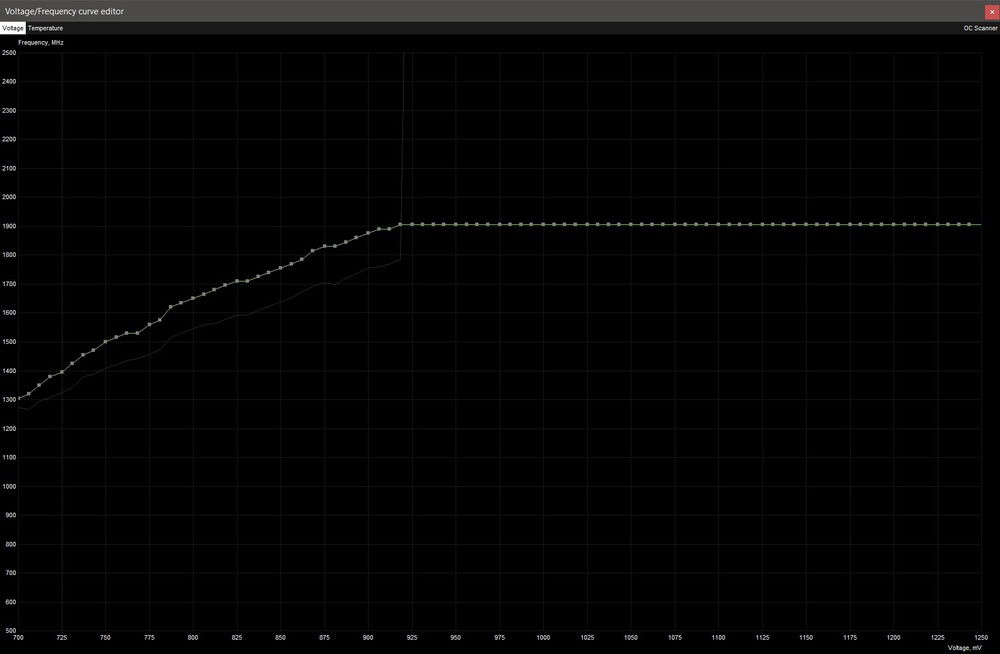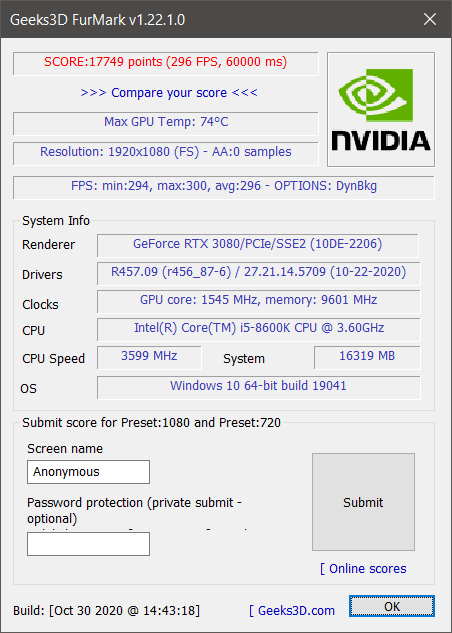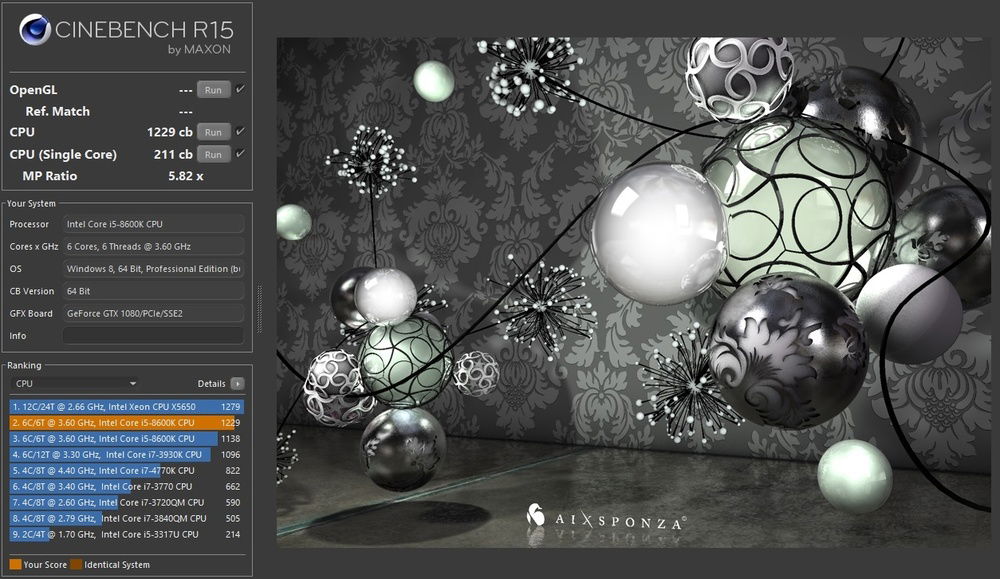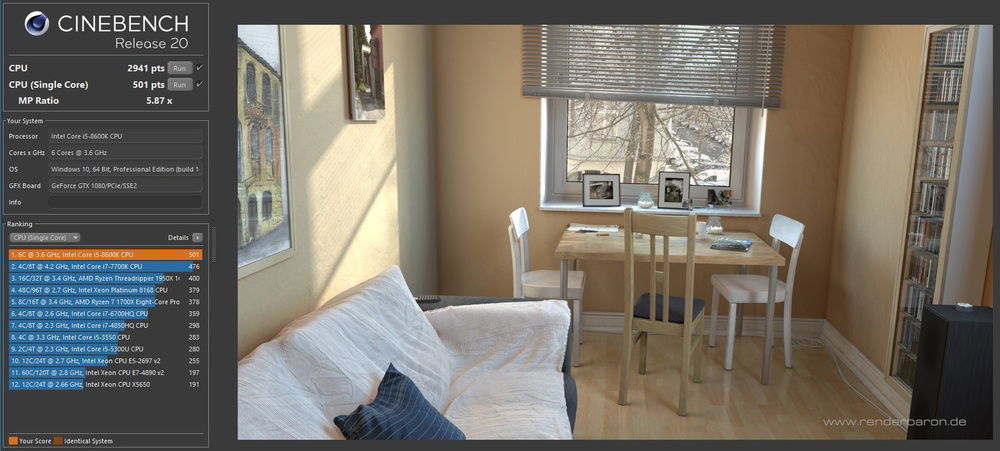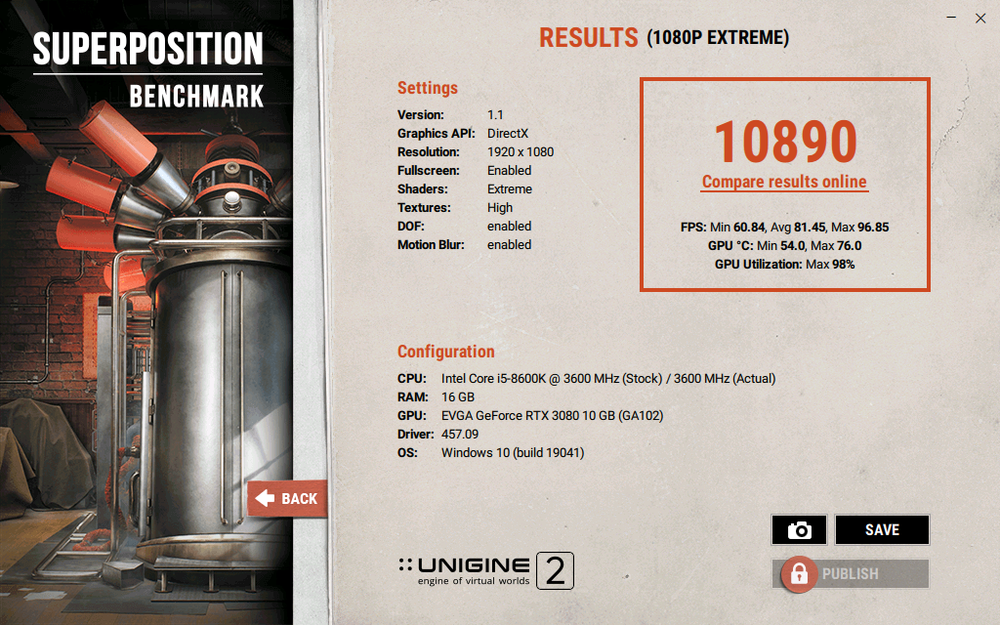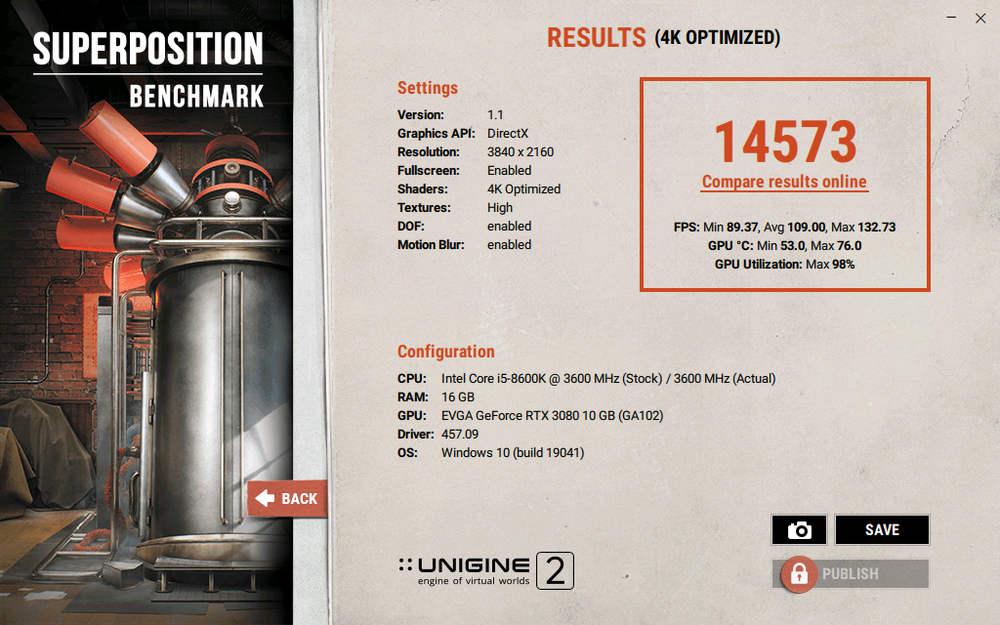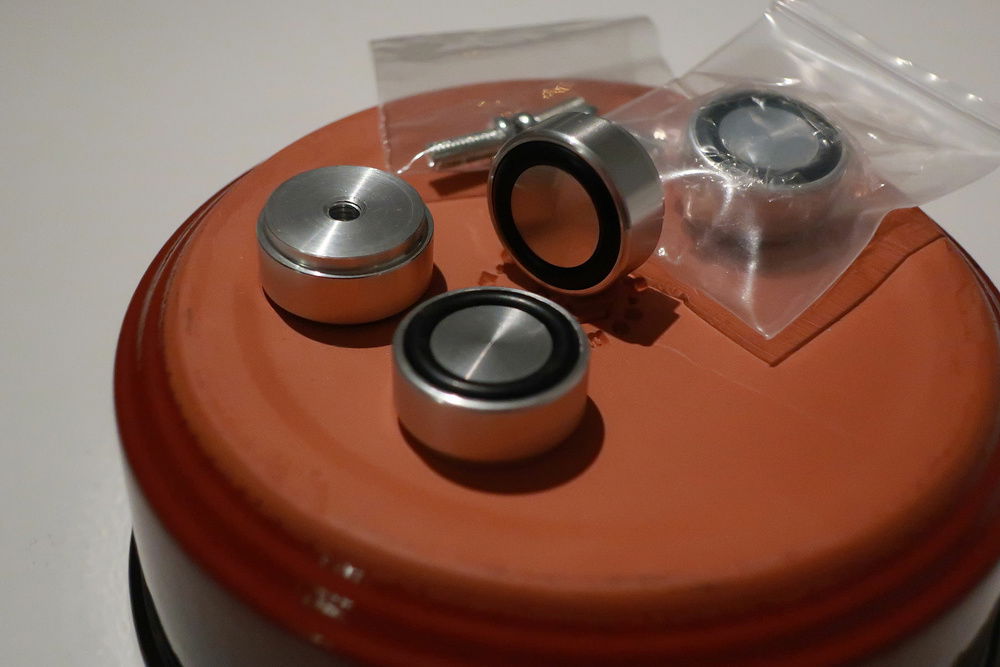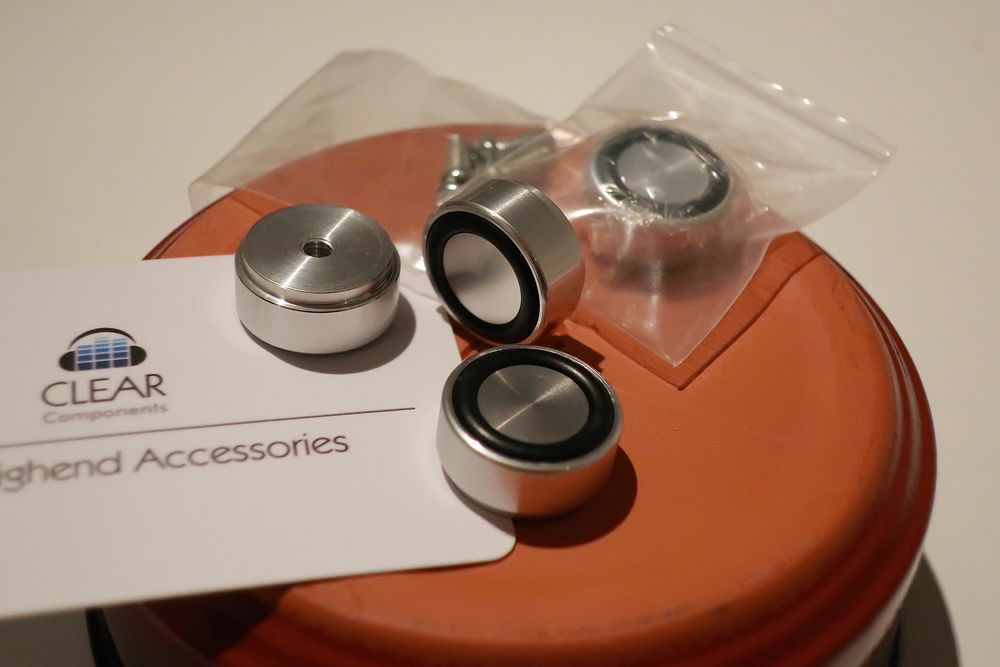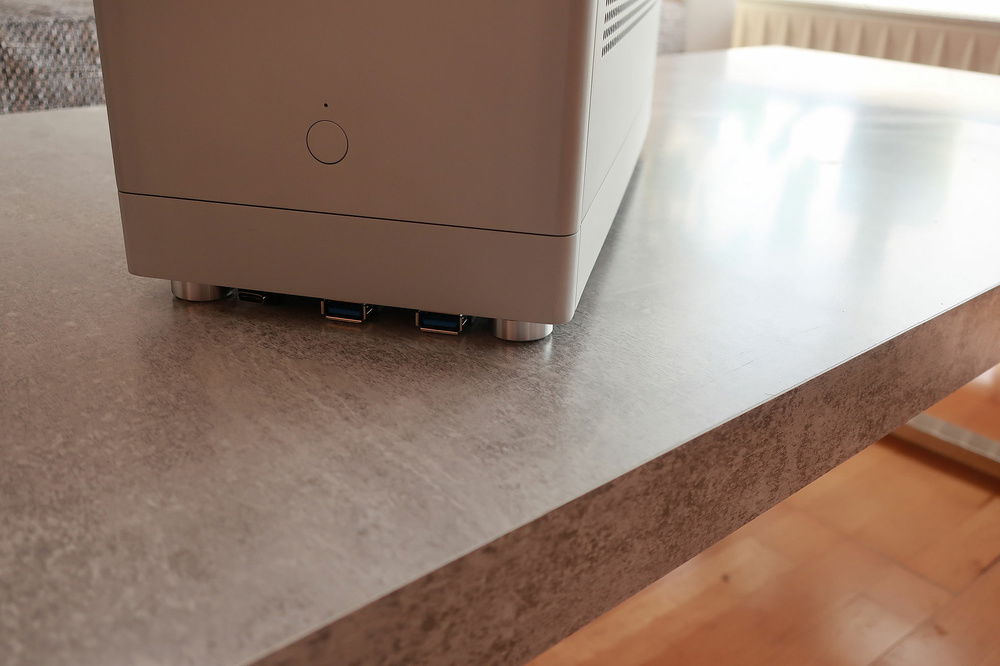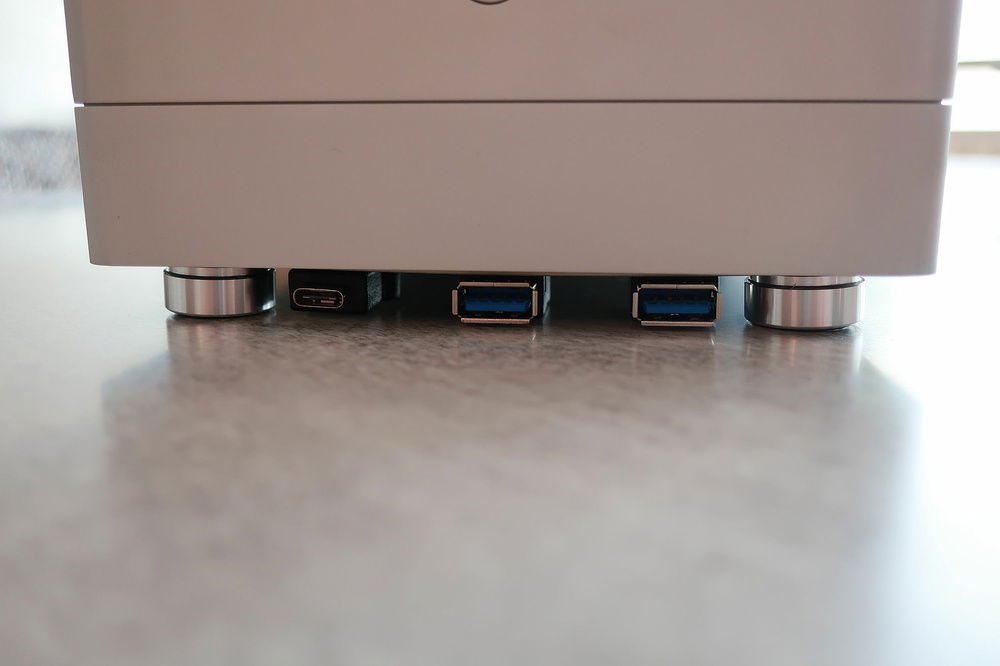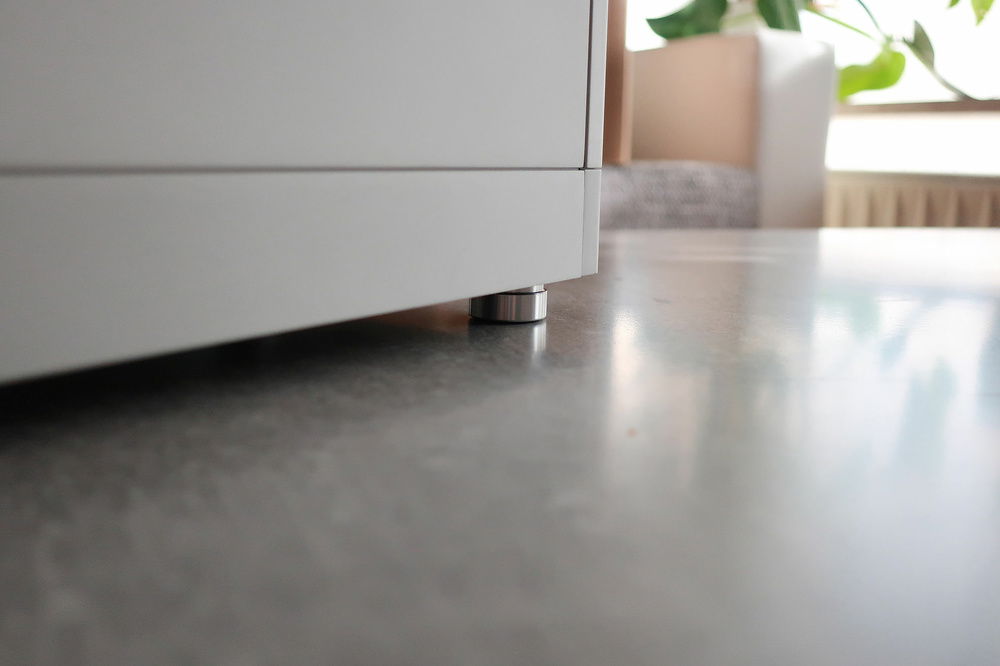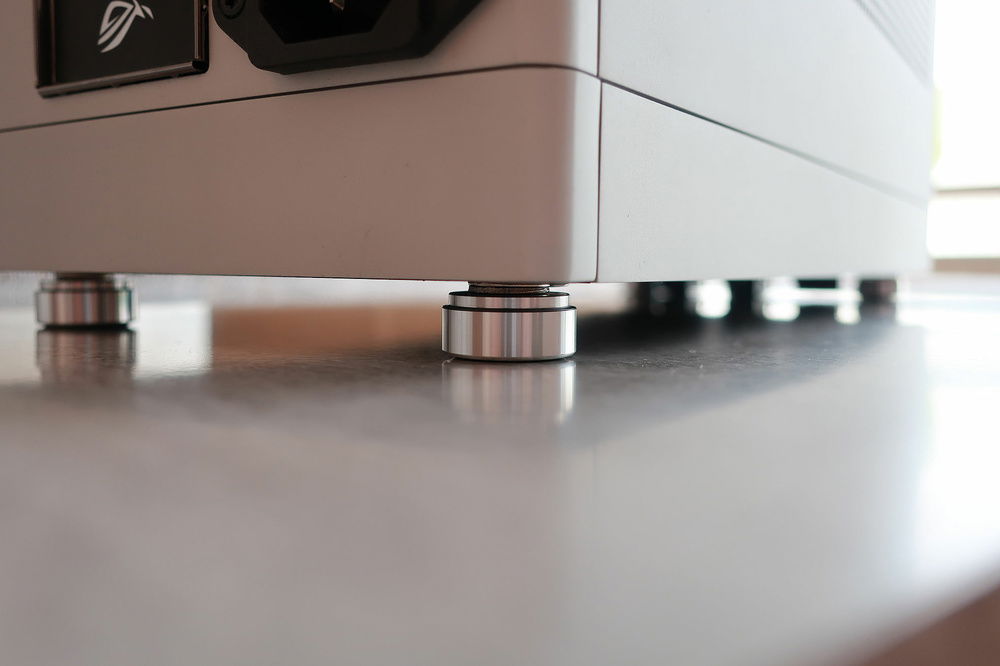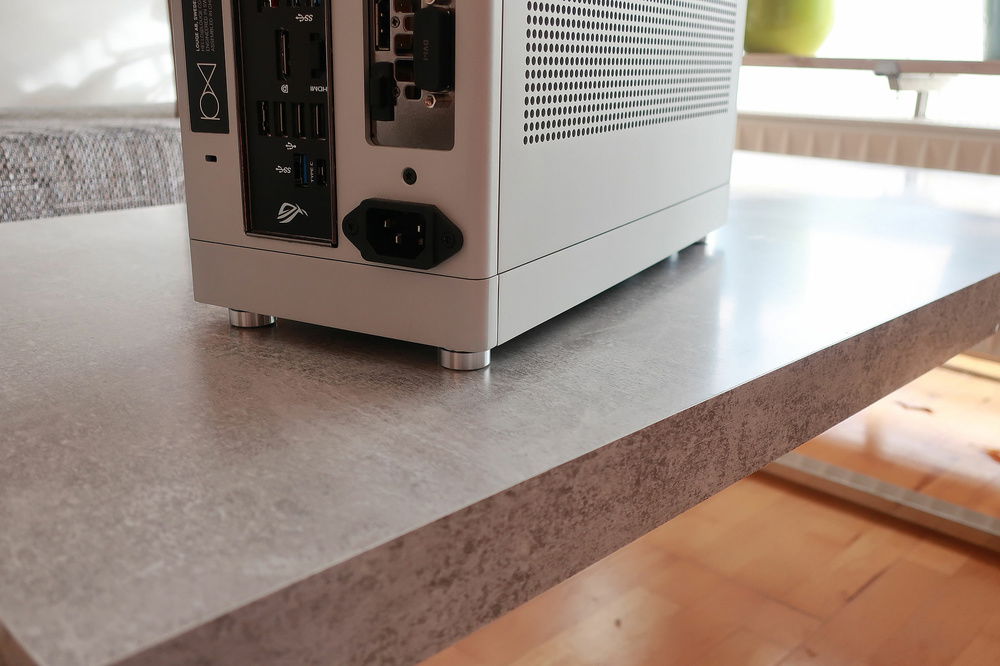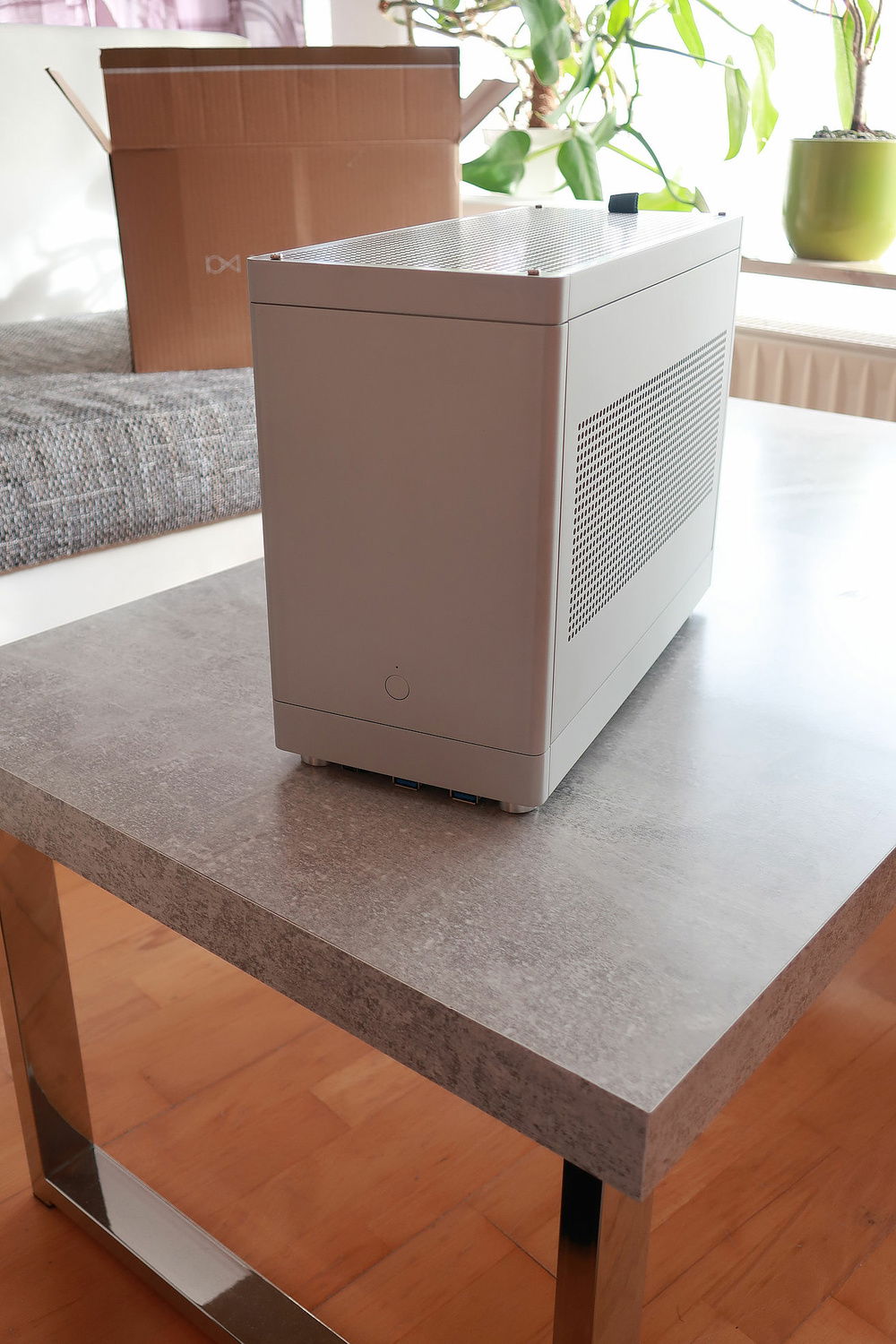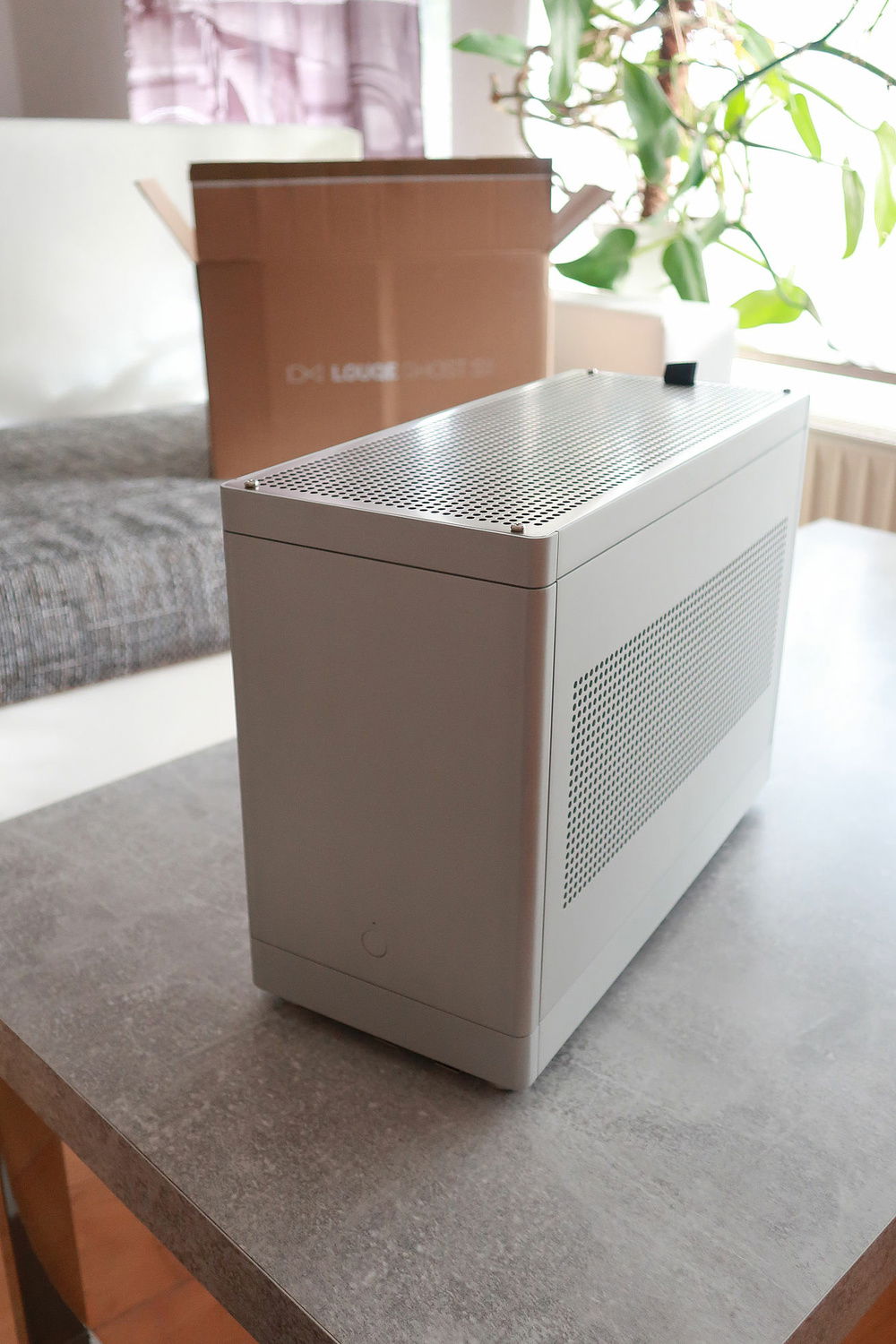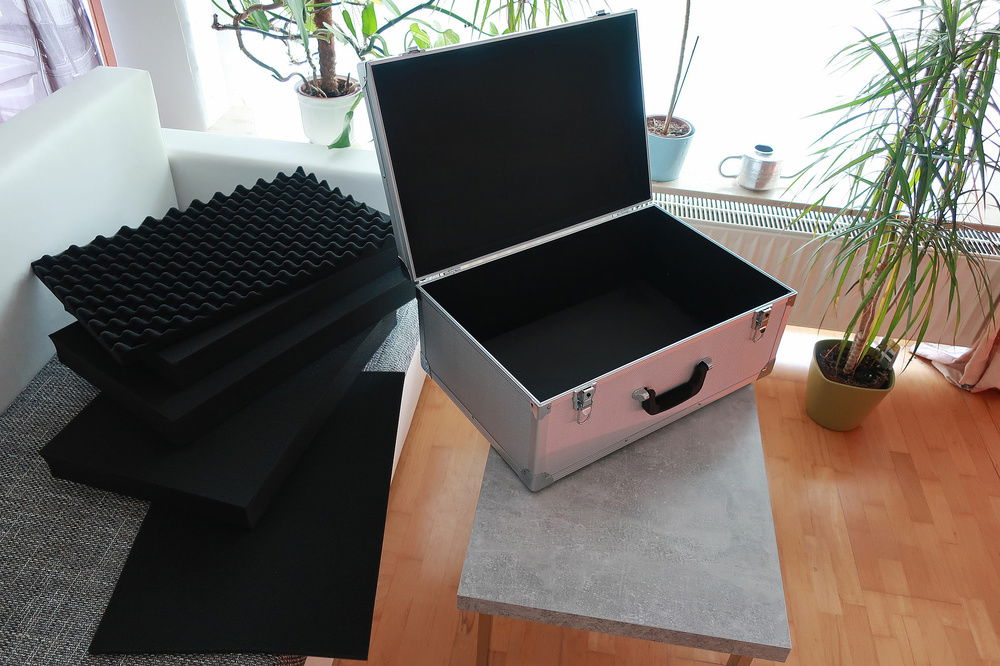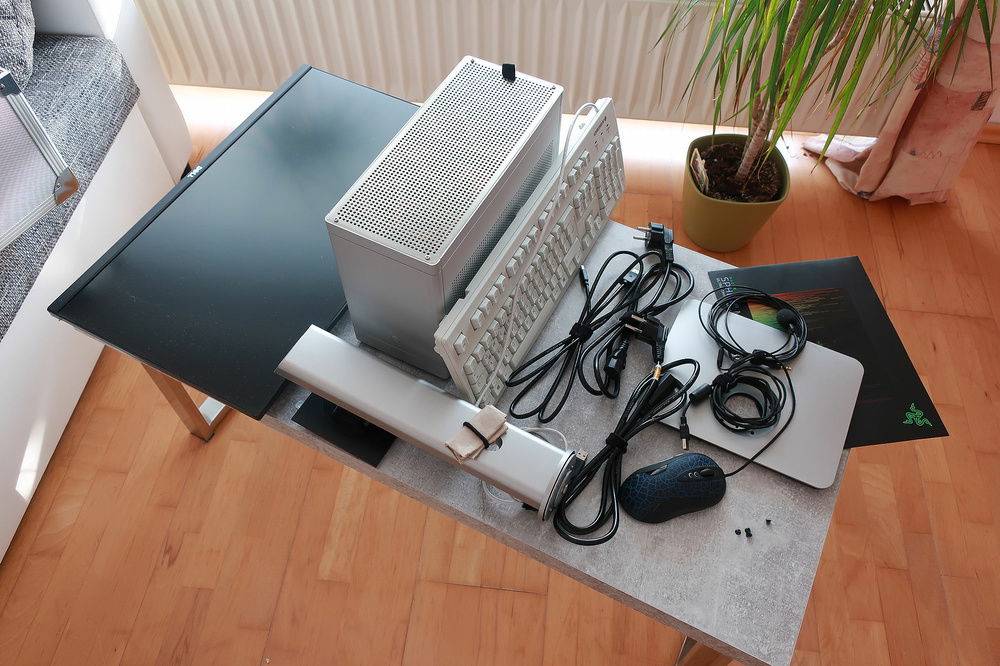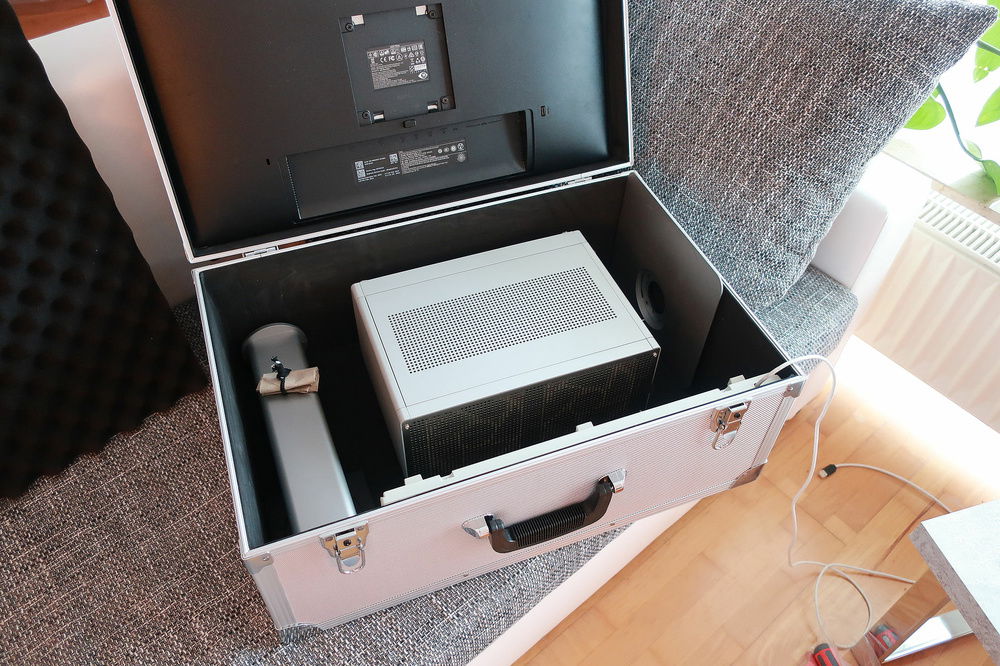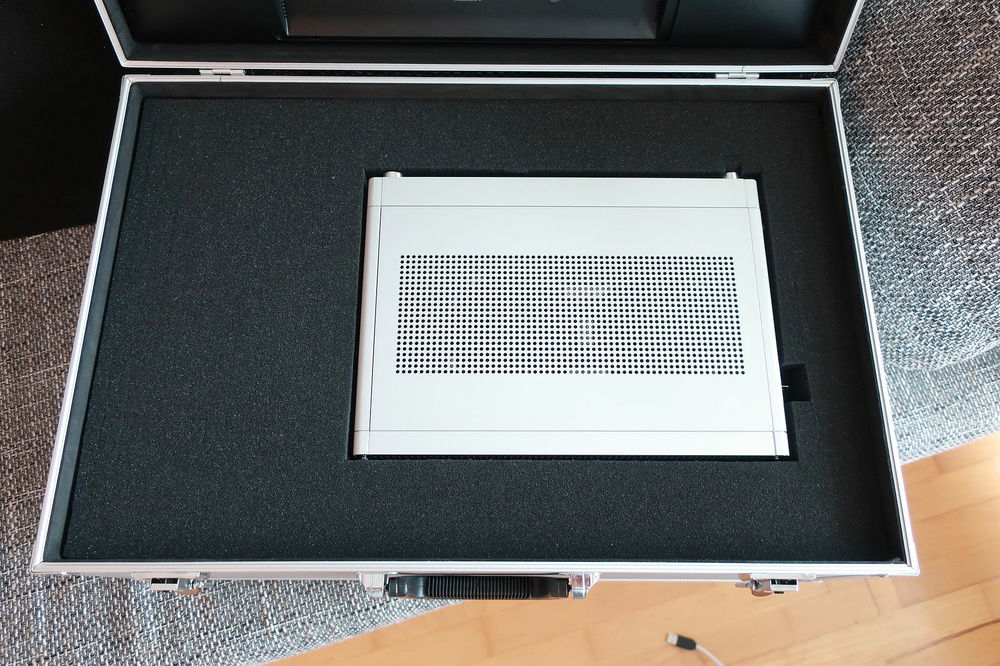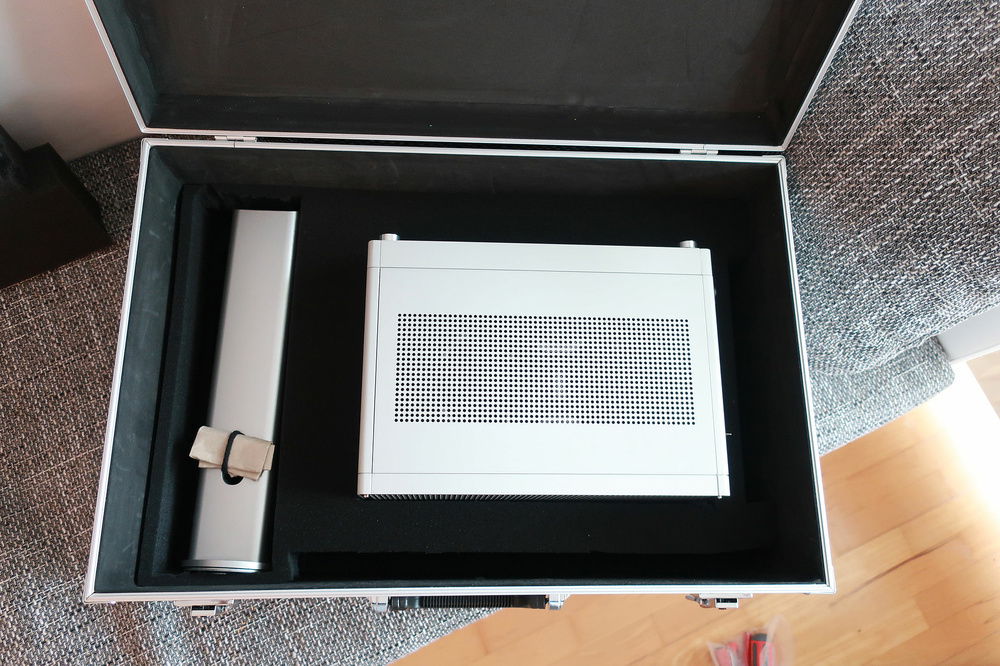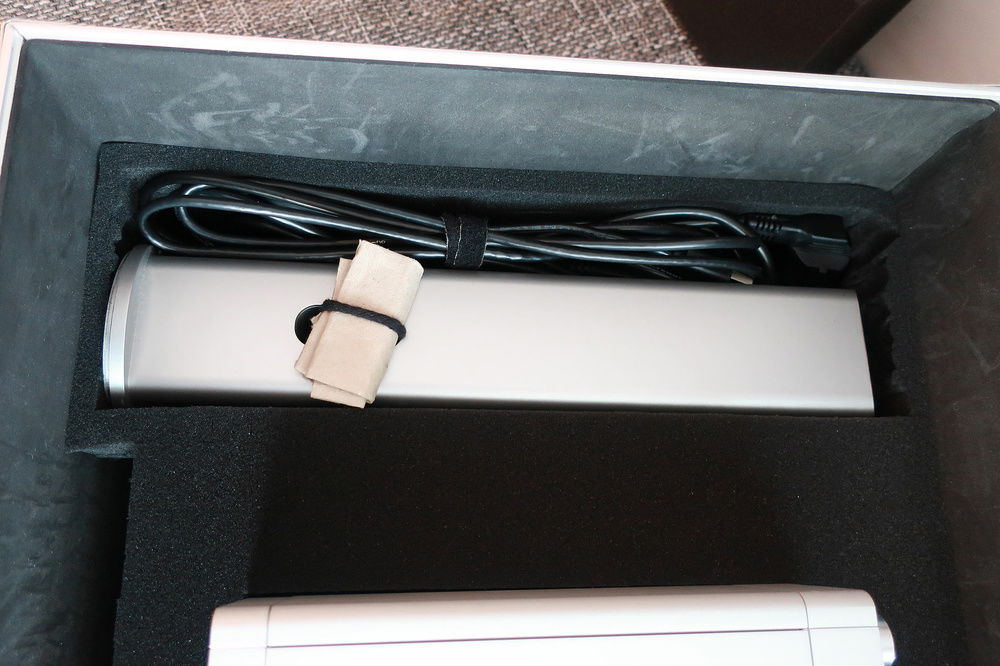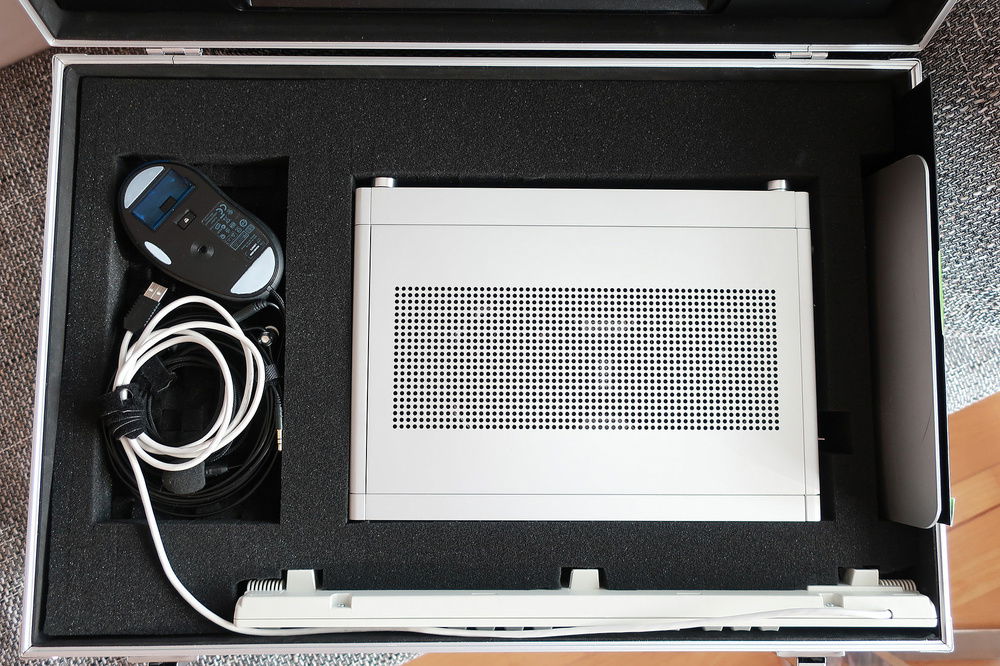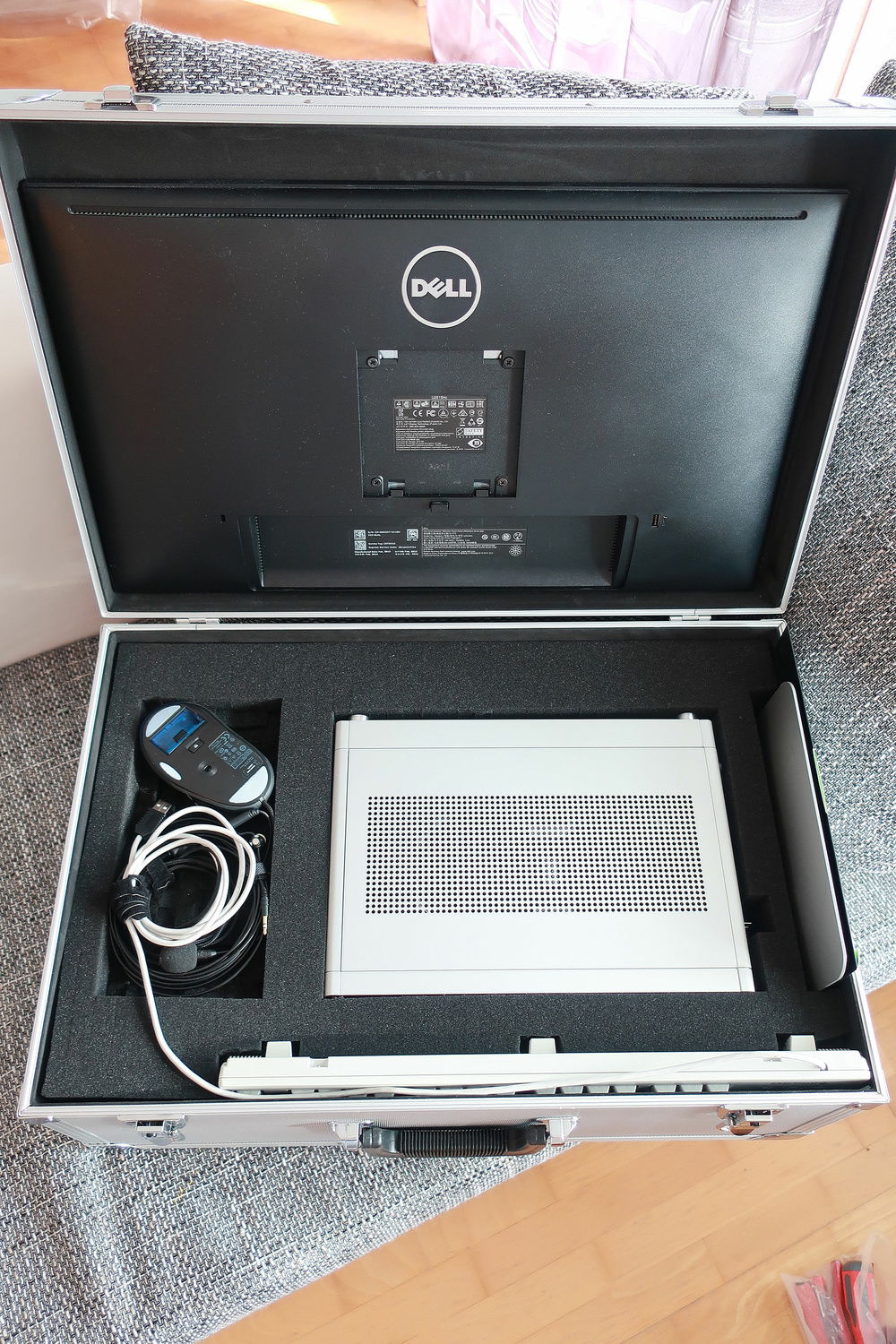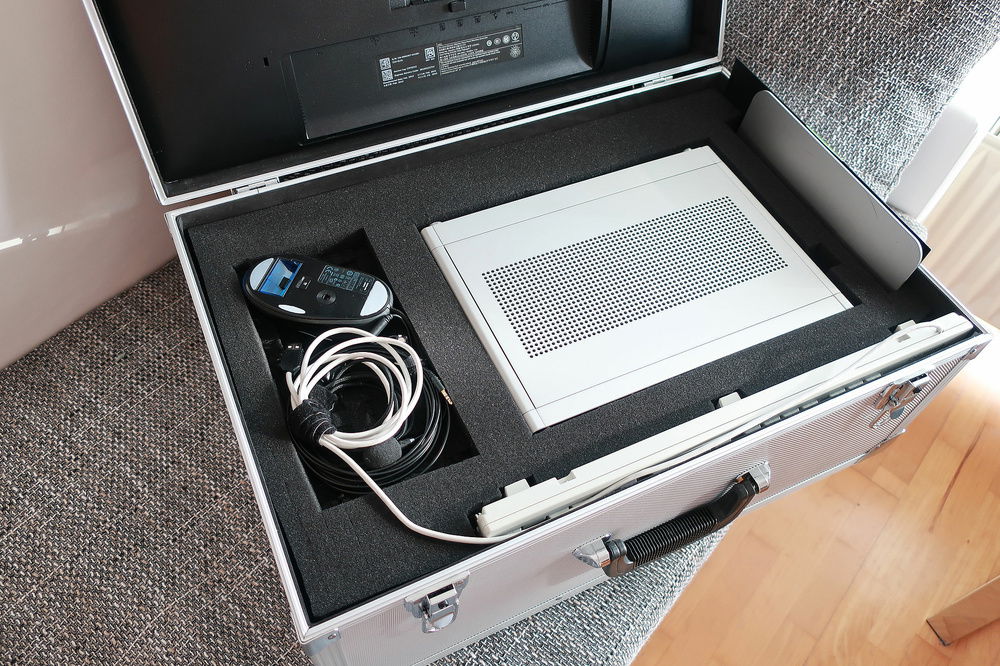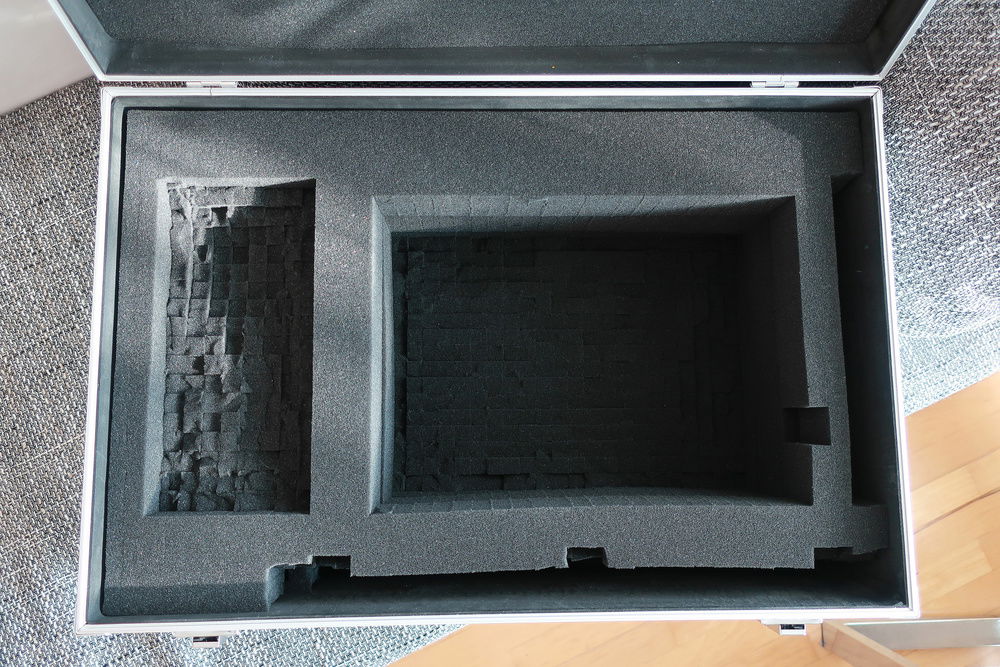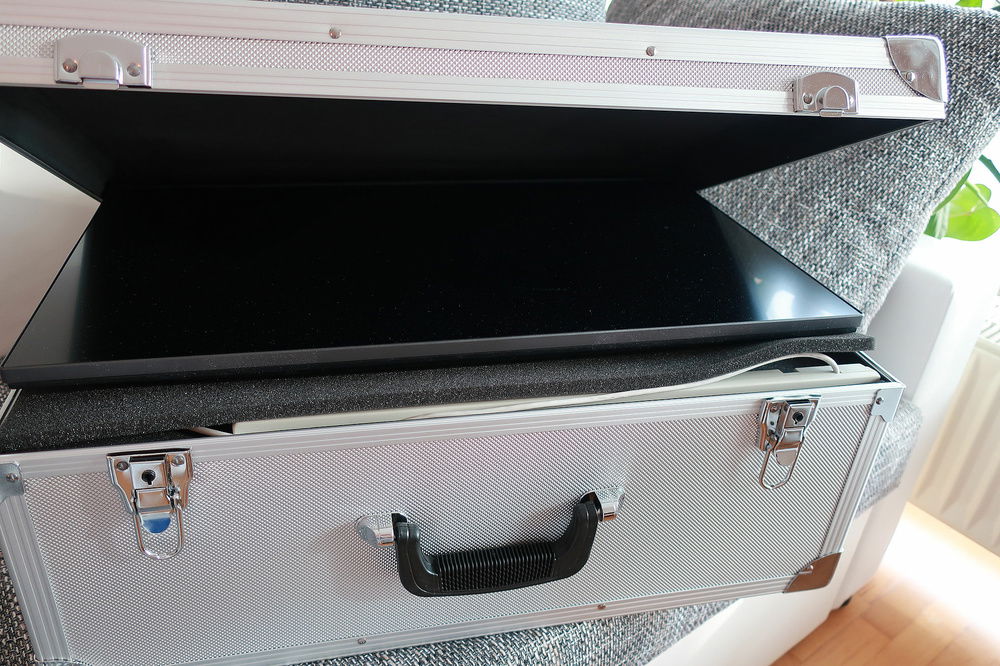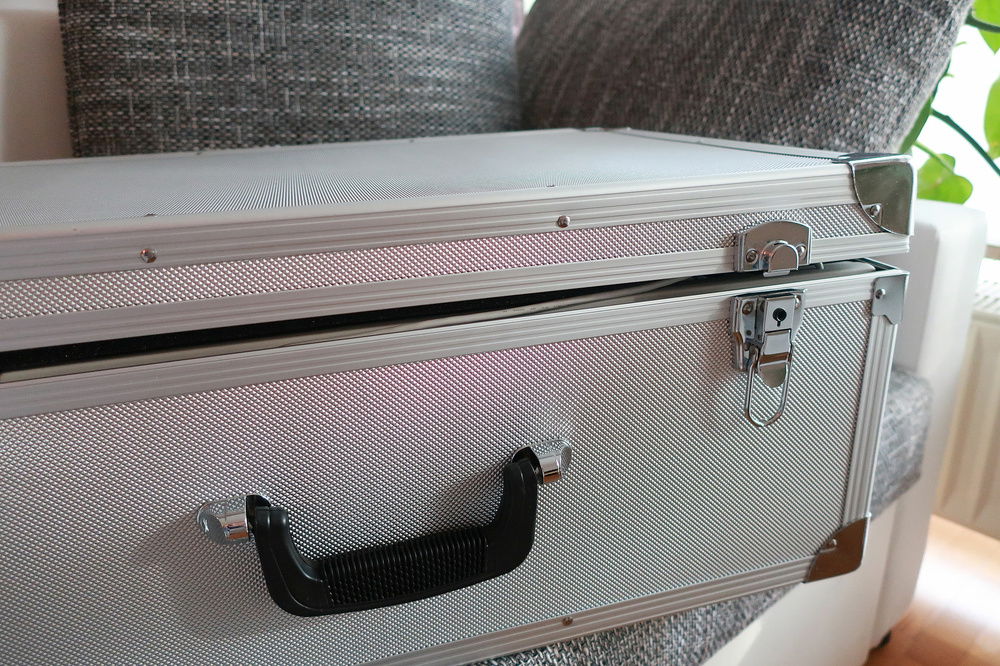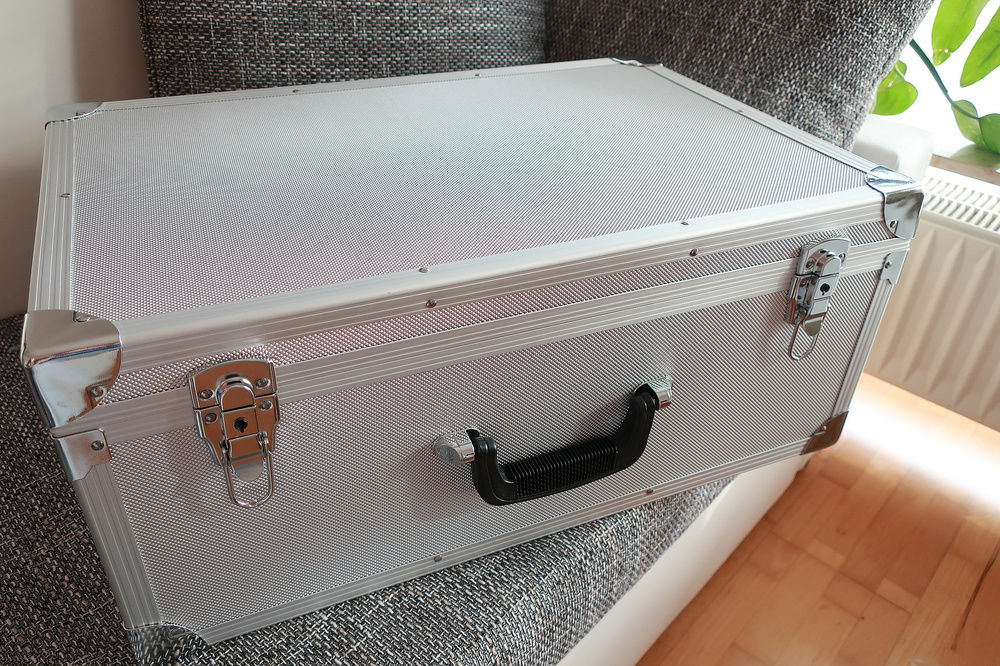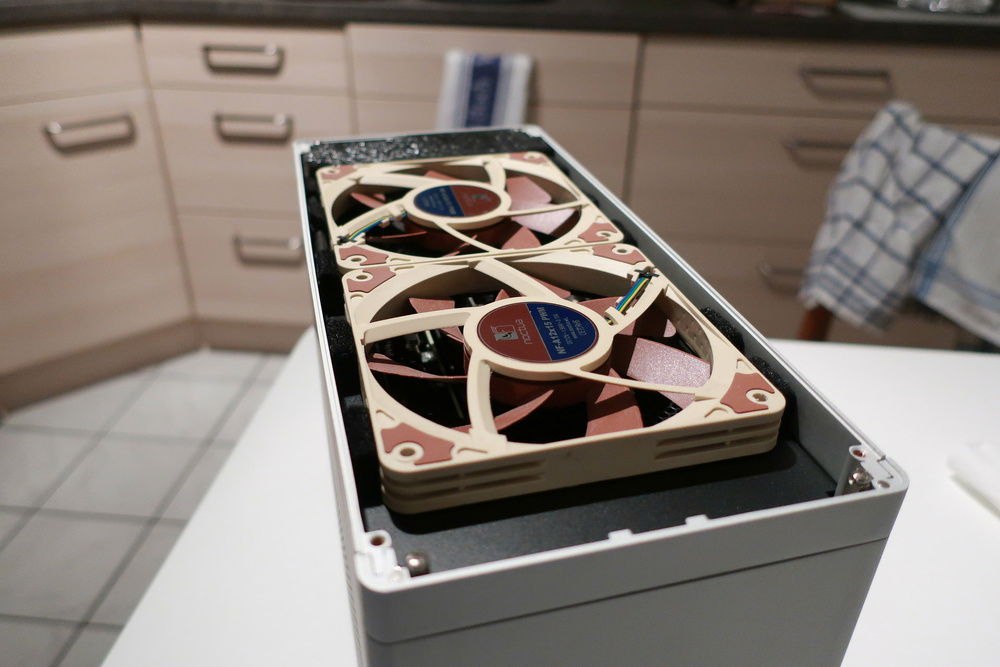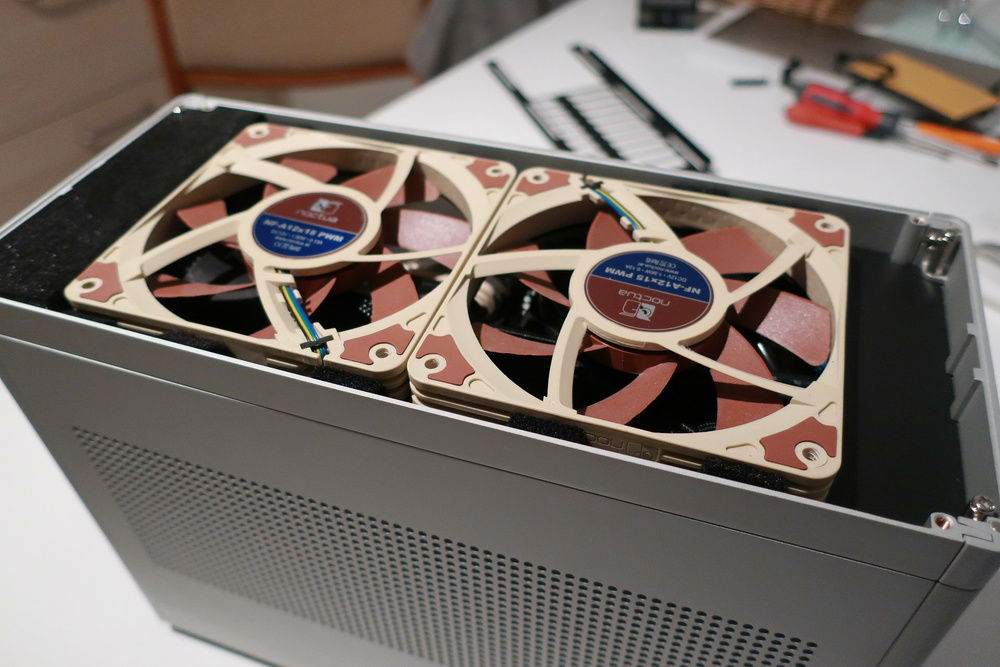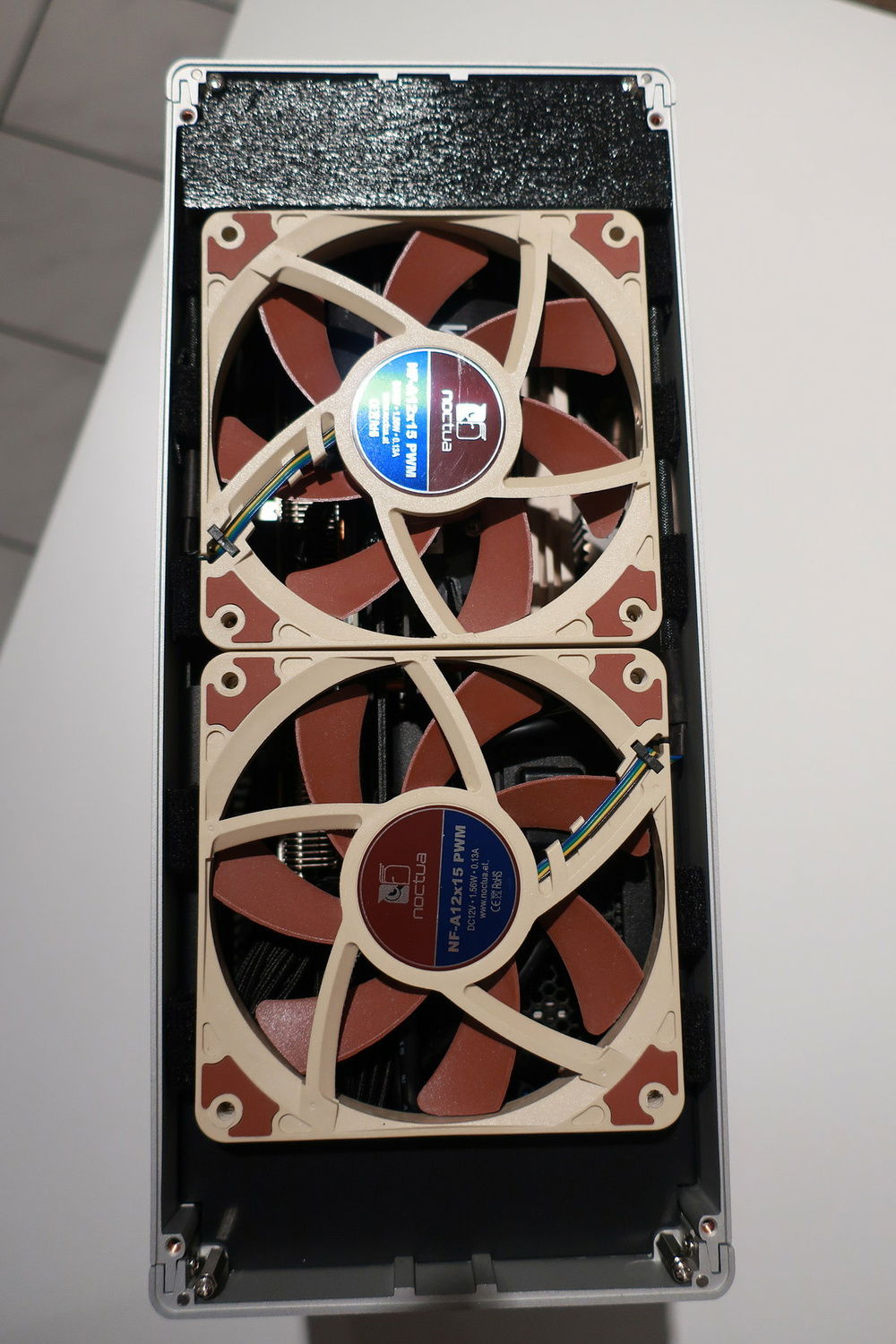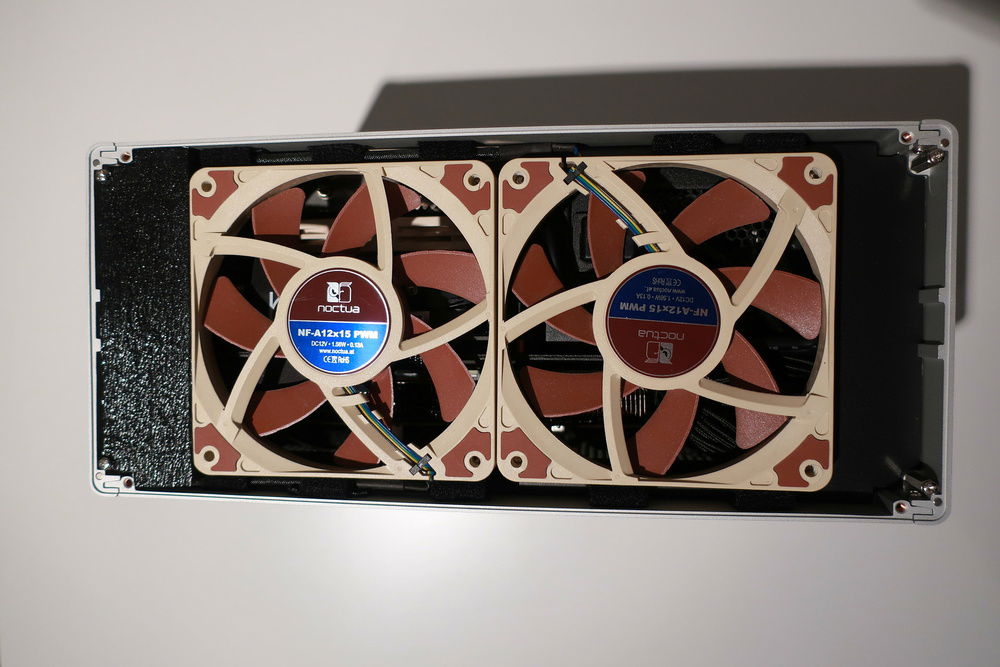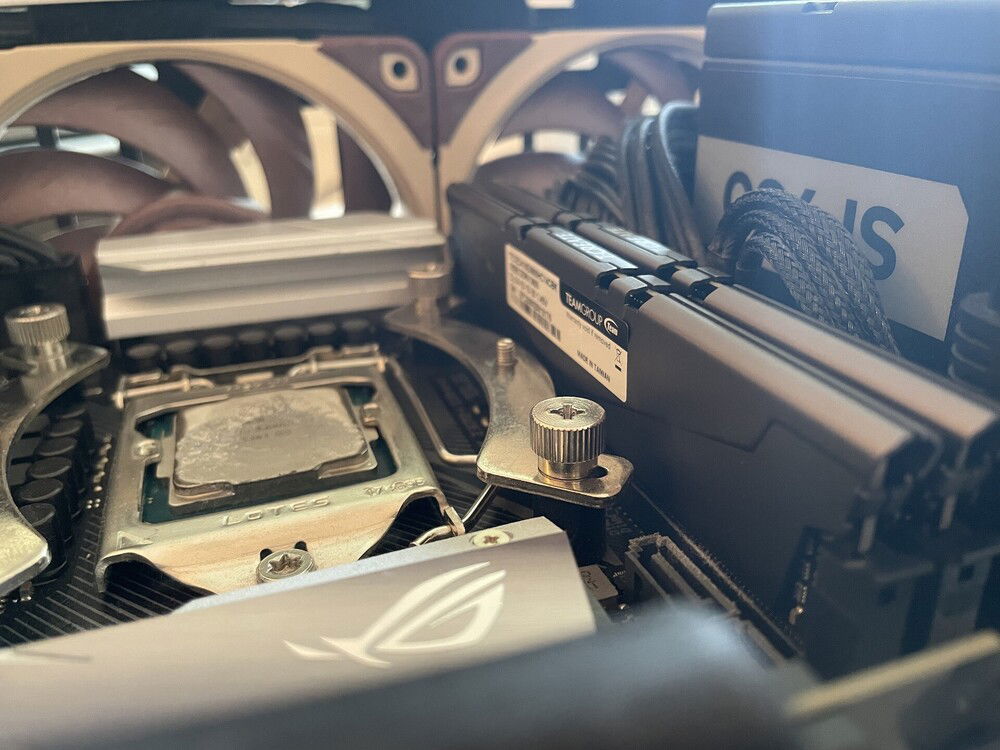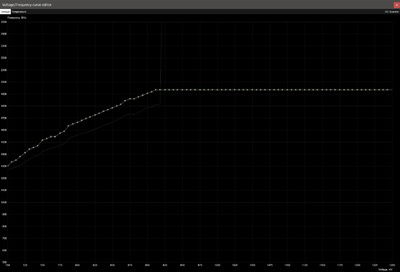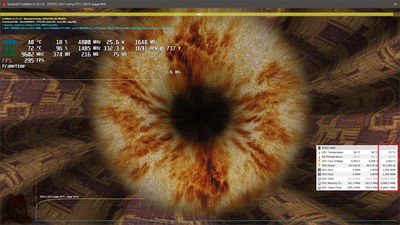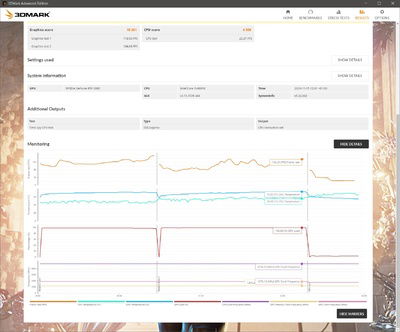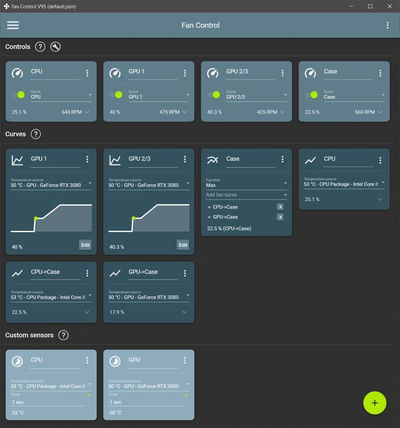Silver Air-Ghost S1 + RTX 3080
In 2018 after a long time of using medium-sized and heavy weight towers (Chieftec CS 601, Nanoxia DS5, Lian-Li v750) i heared of the Ghost S1 on Youtube in a product-preview. This case is very modular. Quality and haptics are very good, there are sometimes issues with sidepanel bending and margins. My preference is an air cooled solution while having a very silent system during idle or low load. I use headphones while gaming, so an increase in loudness is not an issue - e.g. when using 3DMark, Prime95 or similar stresstests. Right now my build is extendend by S-Tophat and M-Tophat. Both house 2x120mm fans and create a negative pressure. This is one of the best performing cooling solutions for a case like the S1.
Fall 2020 with the introduction of a new high performing generation of grafic cards from Nvidia and AMD made me wonder, can my Ghost S1 further improve while still holding on to air cooling only. Starting with unusually bad availability right from the start of the RTX 3080 sales, there was literally no way of testing this front up![Emoji]()
In a private sale i got my hands on a EVGA 3080 XC3 Ultra, knowing it will fit in, i started the challenge to make it work (somehow). Very little information on youtube, reddit, google were available about compatibility with the Louqe Ghost S1 MKII, so in the end there are 3 options: 3080 FE (thermals, bad choice in sandwhich layout cases), EVGA 3080 XC3 (backplate, deshroud, still not a fit), Gigabyte 3090 turbo (good fit, loudness probably will kill you).
My choice for EVGA was final after seeing some weired mods, i further refer to it as "pressed-in-mod" (mounted DynaVox 207270 onto the card). The combination of deshrouding and a slight pressure by the sidepanel enables the card to fit in (the shroud didn't fit by 1-2mm, very sad). No further modifications on the case itself are required - problem A solved. Problem B right from the start, power requirements, my SF450 never will do the job. Best option here is an upgrade to SF750 (holds upto 1000W peak usage). New wiring of 8 pin PCIe cables, they are modular but have an unnecessary second connector - the hell what for? It does work but wastes some room. Here i prefer the SF450 8 pin cables.
Got all components integrated, grafic cards sit's well after the sidepanel is inserted - fans don't have contact to case - lets start some benchmarks and measurements![Emoji]()
Final case dimensions
• Height: 241mm (with feets and top-screws)
• Width: 140mm
• Length: 323mm + 5mm card-braket (standing out)
Modifications and extra parts
• high quality case feets from Clear Components
• custom mountplate from Meta-Customs
• Louqe nickel grill
• front USB A/C extender from Akasa USB USB 3.0, ICR – 32
• DynaVox 207270 case feets for "pressed-in-mod"
• sleeved cable for power-button extension
• Phobya Thermosensor temperature sensor for case fans
Overclocking
• CPU: a delidded 8600k at 4.8GHz AVX stable, ~1.25v core (Prime95 1344k)
• Memory: Corsair LPX 3733MHz (B-Die) at 4000MHz with 1.4v
• GPU: Sure why not... but wait ... let's try that new hype "undervolting"!
The Nvidia Ampere generation eats a lot of power if you let it do so, that usualy results in bad thermals. The goal of undervolting is to limit power consumption while not decreasing performance. Every card has its own power/frequency curve depending on chip quality and cooling.
I am happy with staying around 1900MHz average core clock near 0.912 mV. In default/factory settings Time Spy grafics score is around 17500. With my undervolting/overclocking i reached higher score and a lower temperature. Ain't that nice![Emoji]()
Benchmarks (CPU)
• Cinebench R15 1229 / 211
• Cinebench R20 2941 / 501
• Cinebench R23 7512 / 1304
Benchmarks (GTX 1080)
• FurMark 1080: 7551
• FurMark 1440: 5000
• 3DMark Fire Strike 19563 GPU 23281
• 3DMark Fire Strike Extreme 10101 GPU 11035
• 3DMark Fire Strike Ultra 5456 GPU 5437
• 3DMark Time Spy 7540 GPU 7632
• 3DMark Time Spy Extreme 3419 GPU 3446
Benchmarks (RTX 3080)
You gotta be kidding, that FPS... it's more than double (compared to my GTX 1080).
• FurMark 1080: 17749 (+135%)
• FurMark 1440: 12040 (+141%)
• Superposition 1080p Extreme: 10890
• Superposition 4k Optimized: 14573
• 3DMark Fire Strike 27971 GPU 42703 (+183%)
• 3DMark Fire Strike Extreme 18083 GPU 20753 (+188%)
• 3DMark Fire Strike Ultra 10468 GPU 10808 (+199%)
• 3DMark Time Spy 14664 GPU 18251 (+139%)
• 3DMark Time Spy Extreme 7211 GPU 9122 (+165%)
• 3DMark Port Royal 11597
Thermals and Loudness
You will be surprised - it ain't that crazy at all![Emoji]() (regards to Optimumtech review of 3080 FE in a Ghost S1).
(regards to Optimumtech review of 3080 FE in a Ghost S1).
Temperatures during FurMark and 3DMark are 72 (+/-1) °C . In Doom Eternal gameplay the temperature stays below 65 °C, probably cause of the 141 frame limit. Without a limiter (300-350 fps) temps spike up to 70 °C. While playing Diablo 3 with 141 frame limit, temps stay ~60 °C and the fans are still off![Emoji]()
Made a short recording to give you an impression about loudness: Youtube
Fan Control
Discovered a good alternative for controlling all fans (GPU, CPU, case) with the software "FanControl". It enables a quite unique way of combining multiple inputs (sensors) for one target (eg case-fans). I was finally able to use both CPU- and GPU-temp sensors to adjust case-fanspeed, which is great. I strongly suggest all of you to give it a try.
Power consumption full system
• idle ~44 Watts / ~39.5 Watts screen standby
• Prime95 (1344k) ~180 Watts
• 3DMark (Time Spy) 380-465 Watts
• 3DMark (Time Spy Extreme) 390-433 Watts
• 3DMark (Fire Strike Extreme combined) 420-458 Watts
• Doom Eternal menu (141 fps framelimit) 285-290 Watts
• Doom Eternal menu (no framelimit) 430-435 Watts
Measured with a KD-302.
Fall 2020 with the introduction of a new high performing generation of grafic cards from Nvidia and AMD made me wonder, can my Ghost S1 further improve while still holding on to air cooling only. Starting with unusually bad availability right from the start of the RTX 3080 sales, there was literally no way of testing this front up
In a private sale i got my hands on a EVGA 3080 XC3 Ultra, knowing it will fit in, i started the challenge to make it work (somehow). Very little information on youtube, reddit, google were available about compatibility with the Louqe Ghost S1 MKII, so in the end there are 3 options: 3080 FE (thermals, bad choice in sandwhich layout cases), EVGA 3080 XC3 (backplate, deshroud, still not a fit), Gigabyte 3090 turbo (good fit, loudness probably will kill you).
My choice for EVGA was final after seeing some weired mods, i further refer to it as "pressed-in-mod" (mounted DynaVox 207270 onto the card). The combination of deshrouding and a slight pressure by the sidepanel enables the card to fit in (the shroud didn't fit by 1-2mm, very sad). No further modifications on the case itself are required - problem A solved. Problem B right from the start, power requirements, my SF450 never will do the job. Best option here is an upgrade to SF750 (holds upto 1000W peak usage). New wiring of 8 pin PCIe cables, they are modular but have an unnecessary second connector - the hell what for? It does work but wastes some room. Here i prefer the SF450 8 pin cables.
Got all components integrated, grafic cards sit's well after the sidepanel is inserted - fans don't have contact to case - lets start some benchmarks and measurements
Final case dimensions
• Height: 241mm (with feets and top-screws)
• Width: 140mm
• Length: 323mm + 5mm card-braket (standing out)
Modifications and extra parts
• high quality case feets from Clear Components
• custom mountplate from Meta-Customs
• Louqe nickel grill
• front USB A/C extender from Akasa USB USB 3.0, ICR – 32
• DynaVox 207270 case feets for "pressed-in-mod"
• sleeved cable for power-button extension
• Phobya Thermosensor temperature sensor for case fans
Overclocking
• CPU: a delidded 8600k at 4.8GHz AVX stable, ~1.25v core (Prime95 1344k)
• Memory: Corsair LPX 3733MHz (B-Die) at 4000MHz with 1.4v
• GPU: Sure why not... but wait ... let's try that new hype "undervolting"!
The Nvidia Ampere generation eats a lot of power if you let it do so, that usualy results in bad thermals. The goal of undervolting is to limit power consumption while not decreasing performance. Every card has its own power/frequency curve depending on chip quality and cooling.
I am happy with staying around 1900MHz average core clock near 0.912 mV. In default/factory settings Time Spy grafics score is around 17500. With my undervolting/overclocking i reached higher score and a lower temperature. Ain't that nice
Benchmarks (CPU)
• Cinebench R15 1229 / 211
• Cinebench R20 2941 / 501
• Cinebench R23 7512 / 1304
Benchmarks (GTX 1080)
• FurMark 1080: 7551
• FurMark 1440: 5000
• 3DMark Fire Strike 19563 GPU 23281
• 3DMark Fire Strike Extreme 10101 GPU 11035
• 3DMark Fire Strike Ultra 5456 GPU 5437
• 3DMark Time Spy 7540 GPU 7632
• 3DMark Time Spy Extreme 3419 GPU 3446
Benchmarks (RTX 3080)
You gotta be kidding, that FPS... it's more than double (compared to my GTX 1080).
• FurMark 1080: 17749 (+135%)
• FurMark 1440: 12040 (+141%)
• Superposition 1080p Extreme: 10890
• Superposition 4k Optimized: 14573
• 3DMark Fire Strike 27971 GPU 42703 (+183%)
• 3DMark Fire Strike Extreme 18083 GPU 20753 (+188%)
• 3DMark Fire Strike Ultra 10468 GPU 10808 (+199%)
• 3DMark Time Spy 14664 GPU 18251 (+139%)
• 3DMark Time Spy Extreme 7211 GPU 9122 (+165%)
• 3DMark Port Royal 11597
Thermals and Loudness
You will be surprised - it ain't that crazy at all
Temperatures during FurMark and 3DMark are 72 (+/-1) °C . In Doom Eternal gameplay the temperature stays below 65 °C, probably cause of the 141 frame limit. Without a limiter (300-350 fps) temps spike up to 70 °C. While playing Diablo 3 with 141 frame limit, temps stay ~60 °C and the fans are still off
Made a short recording to give you an impression about loudness: Youtube
Fan Control
Discovered a good alternative for controlling all fans (GPU, CPU, case) with the software "FanControl". It enables a quite unique way of combining multiple inputs (sensors) for one target (eg case-fans). I was finally able to use both CPU- and GPU-temp sensors to adjust case-fanspeed, which is great. I strongly suggest all of you to give it a try.
Power consumption full system
• idle ~44 Watts / ~39.5 Watts screen standby
• Prime95 (1344k) ~180 Watts
• 3DMark (Time Spy) 380-465 Watts
• 3DMark (Time Spy Extreme) 390-433 Watts
• 3DMark (Fire Strike Extreme combined) 420-458 Watts
• Doom Eternal menu (141 fps framelimit) 285-290 Watts
• Doom Eternal menu (no framelimit) 430-435 Watts
Measured with a KD-302.
Color(s): Silver
RGB Lighting? No
Theme: none
Cooling: Air Cooling
Size: Mini-ITX
Type: General Build
Build Updates
Improved airflow - Meta-customs mountplate
Moar Memory :)
High quality case foots
Ghost in the Shell - Travelcase
Hardware
CPU
$ 225.95
Motherboard
$ 589.00
Memory
Graphics
Case
$ 272.05
Case Fan
$ 34.95
Case Fan
$ 34.95
Monitor
Approved by:
